United Kingdom
Country Overview
New Zealand has a strong trading relationship with the United Kingdom, which encompasses England, Scotland, Wales and Northern Ireland. This is based on our shared history, people-to-people links, common values and interests, and ongoing cooperation.
The UK is a liberal market economy with few barriers to entry for establishing new companies, supported by a consistently pro-business government policy agenda.
With its combined population of 68 million, the UK is full of export opportunities for New Zealand businesses. Food and beverage products comprise the bulk of our exports to the UK, led by sheep meat and wine.
The UK is a highly developed and sophisticated consumer market. The greatest opportunity for New Zealand F&B brands is in the premium, value-added market segments with products that are unique and distinctive. Consumer demand is driving changes in business models, especially to online, and demanding greater transparency of supply chains, production systems and brand values.
Trade agreements
With relatively few trade barriers, the United Kingdom serves as the entry market into Europe for many New Zealand companies. Despite Brexit, the UK will continue to have a strong people and trading connection with Europe. New Zealand is looking to deepen its trading links within the region and is in free trade negotiations with both the UK and the EU.
Some New Zealand meat and dairy exports to the UK are subject to Tariff Rate Quotas (TRQs).
Country intelligence
The Robinson Country Intelligence Index is a holistic measurement of country-level risk and serves as an alternative measure of country development. It incorporates four broad dimensions of Governance, Economics, Operations and Society. A higher ranking indicates a better Country Intelligence Index score.

Value of New Zealand exports

International logistics performance
The International Logistics Performance Index measures how efficiently countries move goods across and within borders. Countries are ranked on their index score with a higher ranking indicating higher performance of trade logistics based on six components: customs, infrastructure, ease of international shipments, logistics services quality and competence, tracking and tracing, and timeliness.

Income and distribution of wealth
Global National Income (GNI) per capita is the dollar value of a country's final income in a year, divided by its population.
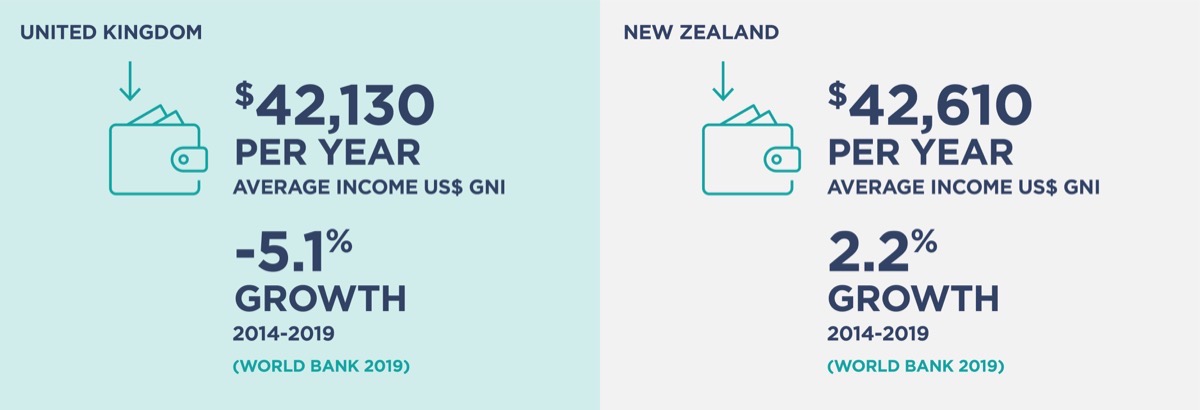
Annual Disposable Income refers to gross income minus social security contributions and income taxes. Each income band presents data referring to the percentage of households with a disposable income over that amount.
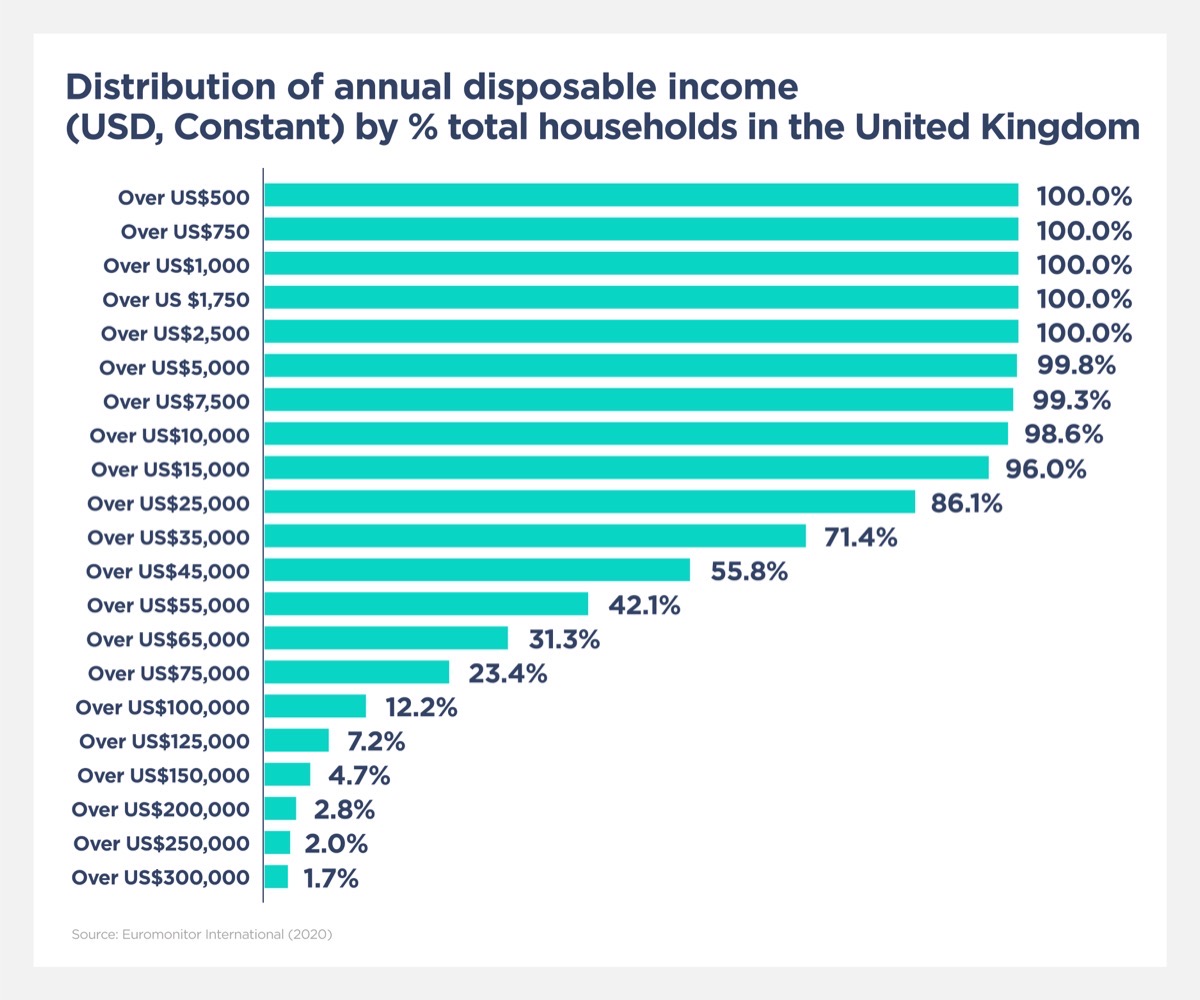
Further information
For more information to validate the United Kingdom as an export market, see our United Kingdom Market Guide.
- Vitamins & Dietary Supplements
- Skin Care
- Dog & Cat Food
- Alcoholic Drinks
- Health & Wellness Packaged Food & Beverages
Vitamins & Dietary Supplements
- Market size and growth
-
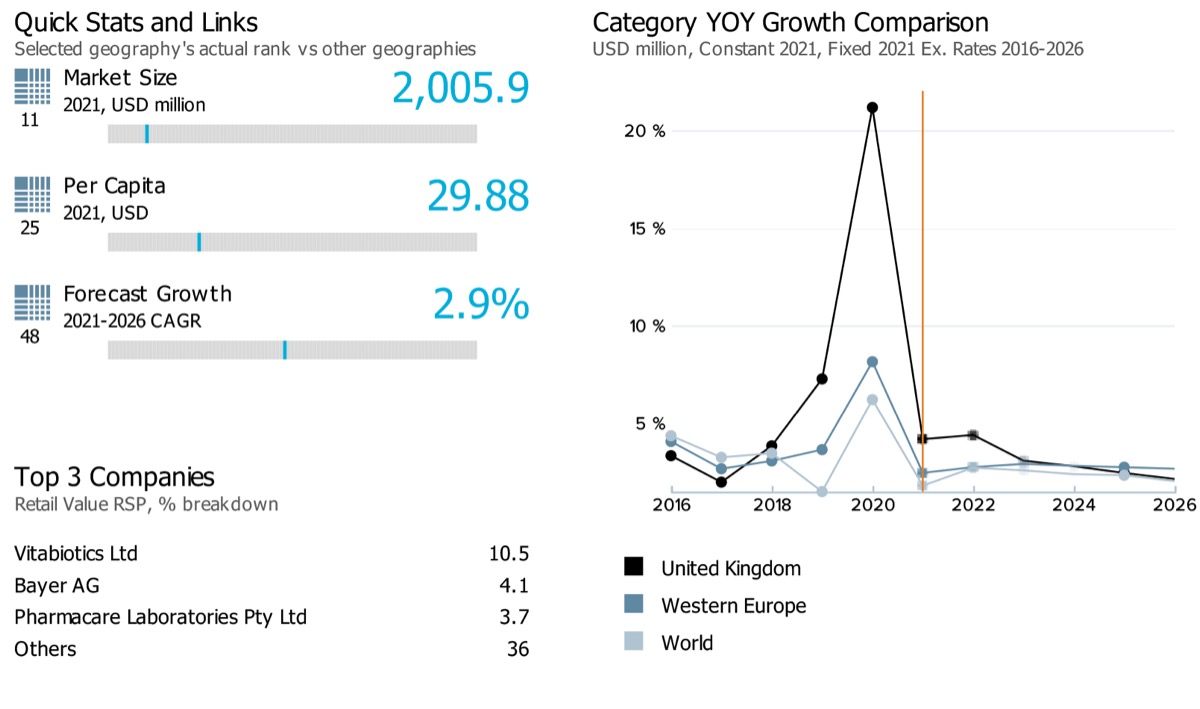
Note: Data on the top left corner of the image (11, 25 and 48) showcases respective ranks for the UK for its market size, per capita, and forecast growth rate compared against 99 countries globally. The blue line on the grey bar represents the relative position of the country as per their rank.
Note: Latest market size data for the year 2021 has been shared for Vitamins & Dietary Supplements
The UK's retail value sales of vitamins and dietary supplements witnessed a historic compound annual growth rate (CAGR) of 9.4% during 2016-2021. It is further expected to decline at a retail value CAGR of 2.9% over 2021-2026. The expected slowdown in the country is stronger than the global performance of the category, where it witnessed a historic CAGR of 5.1% and an estimated slowdown for the forecast CAGR of 2.4% over the same period for its retail value sales.
- Sub-category breakdown
-
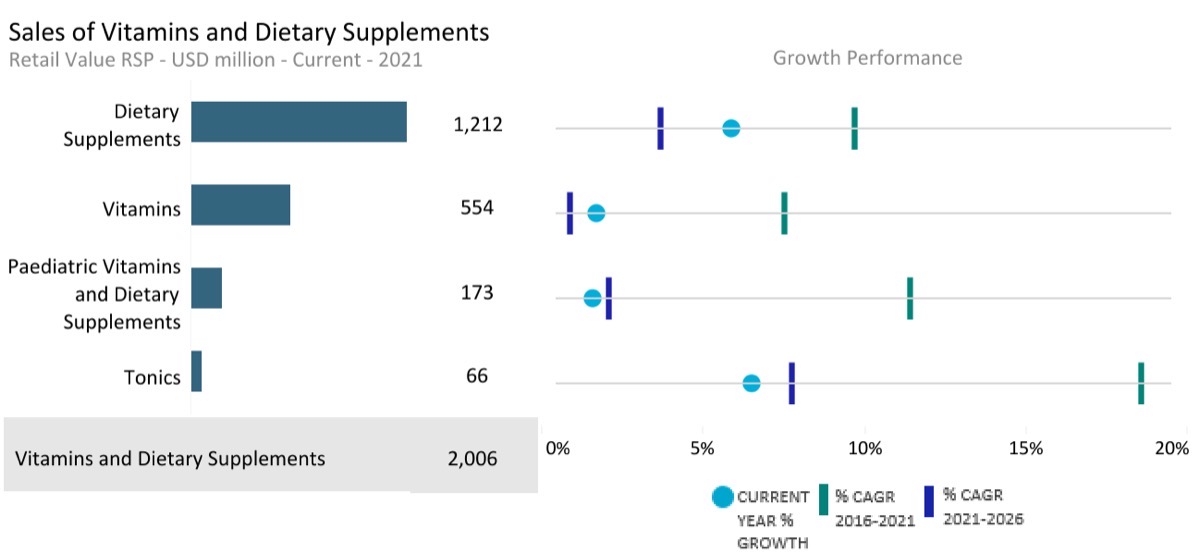
Note: Current year growth in the above chart refers to the period 2021-22
Category
Unit
Market size (2021)
Retail value RSP
Forecast compound annual growth rate (2021/2026) %
Vitamins and Dietary Supplements
USD million
2,005.89
2.95
Vitamins
USD million
554.39
0.86
Paediatric Vitamins and Dietary Supplements
USD million
173.47
2.09
Dietary Supplements
USD million
1,211.79
3.69
Tonics
USD million
66.24
7.76
- Channel distribution
-
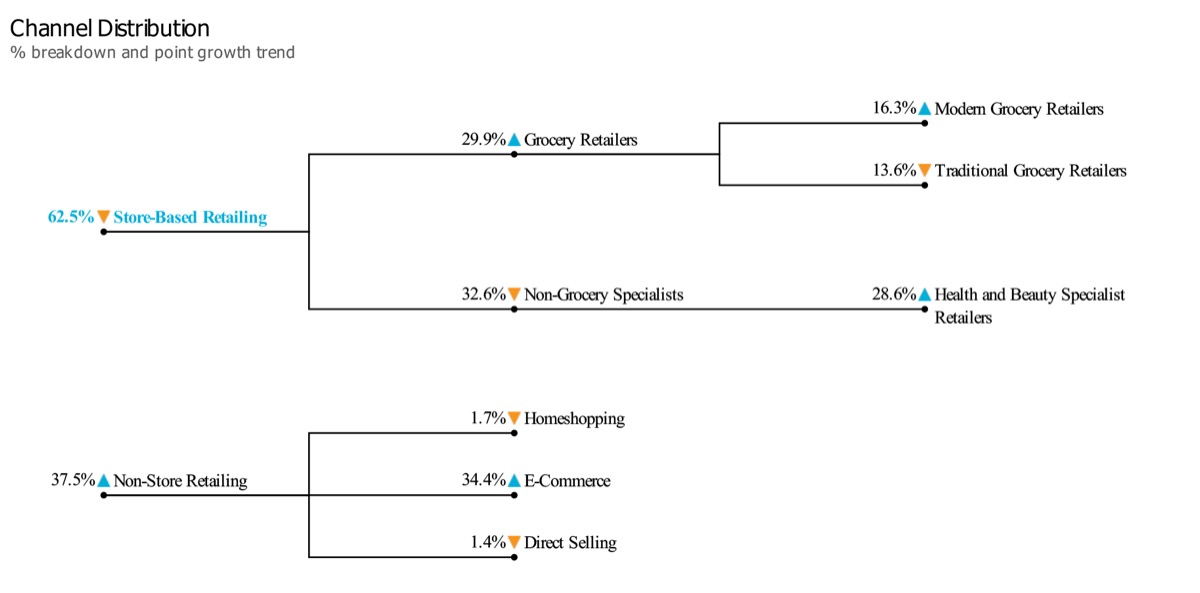
Note: The chart here showcases the retail value share of different channel sales for Vitamins and dietary supplement products in the UK in 2021. The triangle/dash represents whether the specific channel share has increased/decreased or remained the same against its share in the previous year.
- Market Insights
-
Market trends
- The emergence of COVID-19 positively impacted the consumer health industry in the UK in 2020 due to unusual stockpiling behaviour, focus on preventive health and consumers adjusting to the new normal. From a preventive health perspective, immunity-boosting and general health products remained the biggest driving force within vitamins and dietary supplements in 2020.
- Mineral supplements, Echinacea and probiotic supplements are expected to grow over the forecast period ahead of the category’s general performance in 2020. This is largely due to their links with greater immune-boosting attributes and the increased importance consumers placed on these products throughout the year due to the pandemic.
Prospects and growth opportunity
- As consumers begin to take a renewed interest in their health through supplementation, consumers are likely to deal with pill fatigue over the forecast period to 2026. This offers an opportunity for players to come up with alternative formats such as powder, gummies and sprays. Whilst spray formats of single vitamins have been present in the UK for some time through brands such as BetterYou, 2020 witnessed the acceleration of this trend with MyVitamins and The Nue Co. pre-empting pill fatigue by launching spray formats.
- Also, an opportunity exists in mental health and wellness over the forecast period as consumers begin to recognise the toll of COVID-19 and social isolation on their lives. Other herbal/traditional dietary supplements are especially likely to benefit from this opportunity. Consumers might consider taking CBD (Cannabidiol) products to address anxiety and sleep issues.
General health & wellness trends
- The emergence of COVID-19 has shifted the consumer health landscape in the UK, exacerbating growth or decline in some categories and exposing U-turns in consumer behaviour. The most affected categories were those tied to lifestyle choices, such as motion sickness remedies linked closely to travel or sports protein RTD (ready to drink) due to the closure of gyms and other athletic spaces. However, in 2021, consumers are expected to continue to hold stock of medicinal remedies for “just in case” situations and continue investing in probiotic supplements, and vitamins and dietary supplements should discretionary incomes remain high.
- Vitabiotics is in prime position to succeed in a post-COVID-19 landscape due to its wide-ranging portfolio spanning women’s health, men’s health, children’s health and 50+ health.The company focuses mainly on particular areas that will remain key throughout the forecast period as consumers place greater importance on their health through immune support, at-home work performance, energy products, and the importance of healthy ageing through collagen-enhanced and menopause-positioned products.
Skin Care
- Market size and growth
-
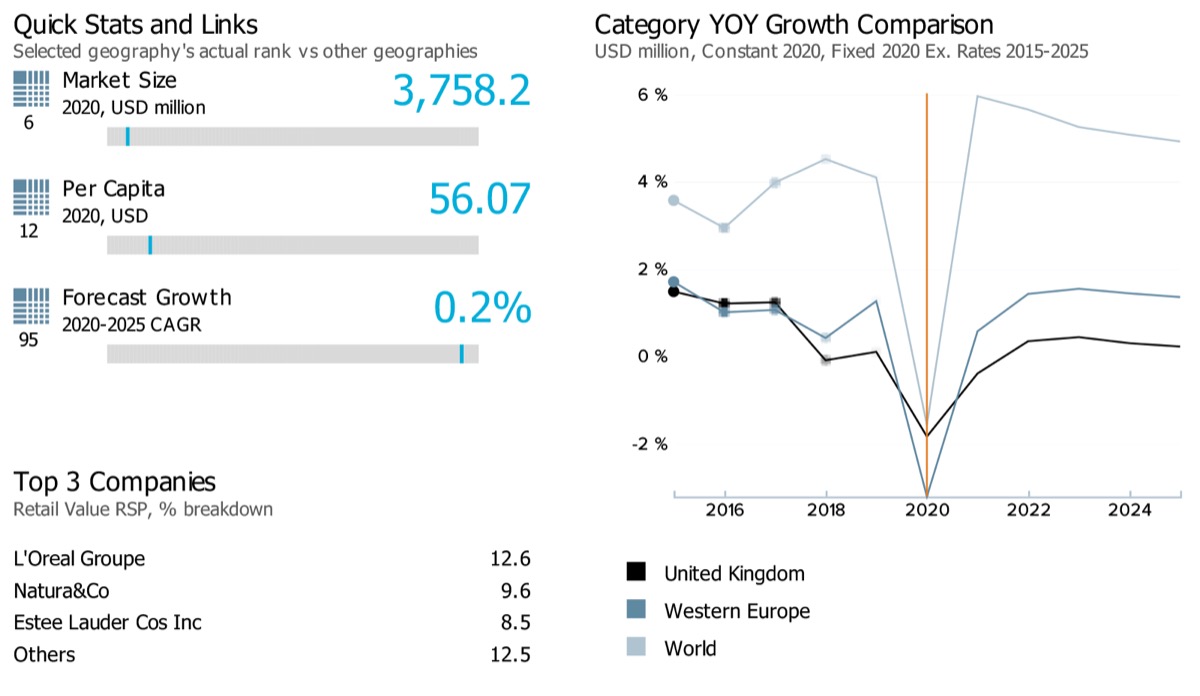
Note: Data on the top left corner of the image (6, 12 and 95) showcases respective ranks for the UK for its market size, per capita, and forecast growth rate compared against 99 countries globally. The blue line on the grey bar represents the relative position of the country as per their rank.
Retail value sales of skin care products in the UK are expected to witness a slight slowdown in compound annual growth rate (CAGR) from 2015-2020 (1.8%) to 0.2% over 2020-2025. However, the category’s performance is expected to strengthen at the global level from a retail value CAGR of 4.7% during 2015-2020 to 5.3% over 2020-2025.
- Sub-category breakdown
-
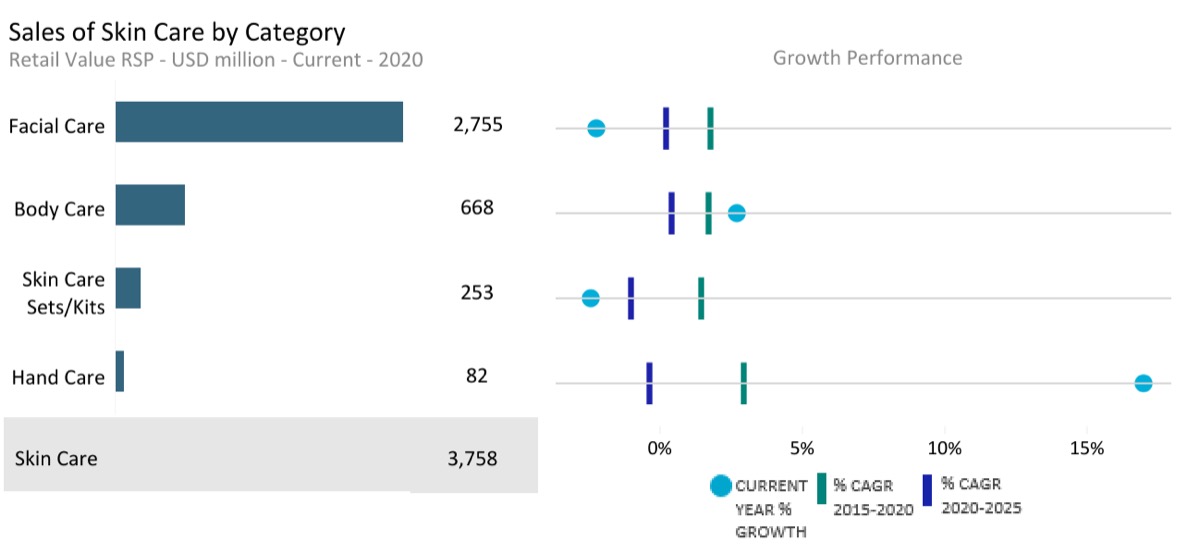
Note: Current year growth in the above chart refers to period 2019-20
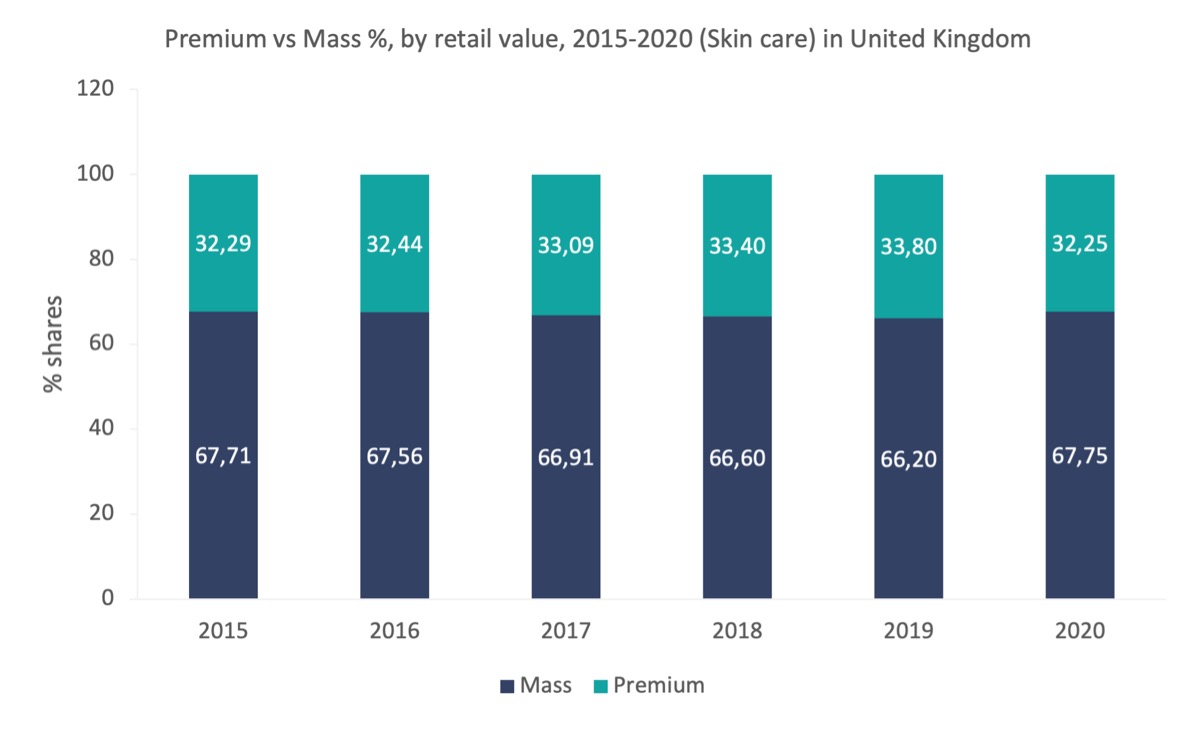
Category
Unit
Market size (2020)
Retail value RSP
Forecast compound annual growth rate (2020/2025) %
Skin Care
USD million
3,758.23
0.16
Body Care
USD million
668.04
0.40
Facial Care
USD million
2,755.02
0.22
Hand Care
USD million
82.44
-0.36
Skin Care Sets/Kits
USD million
252.74
-1.04
- Channel distribution
-
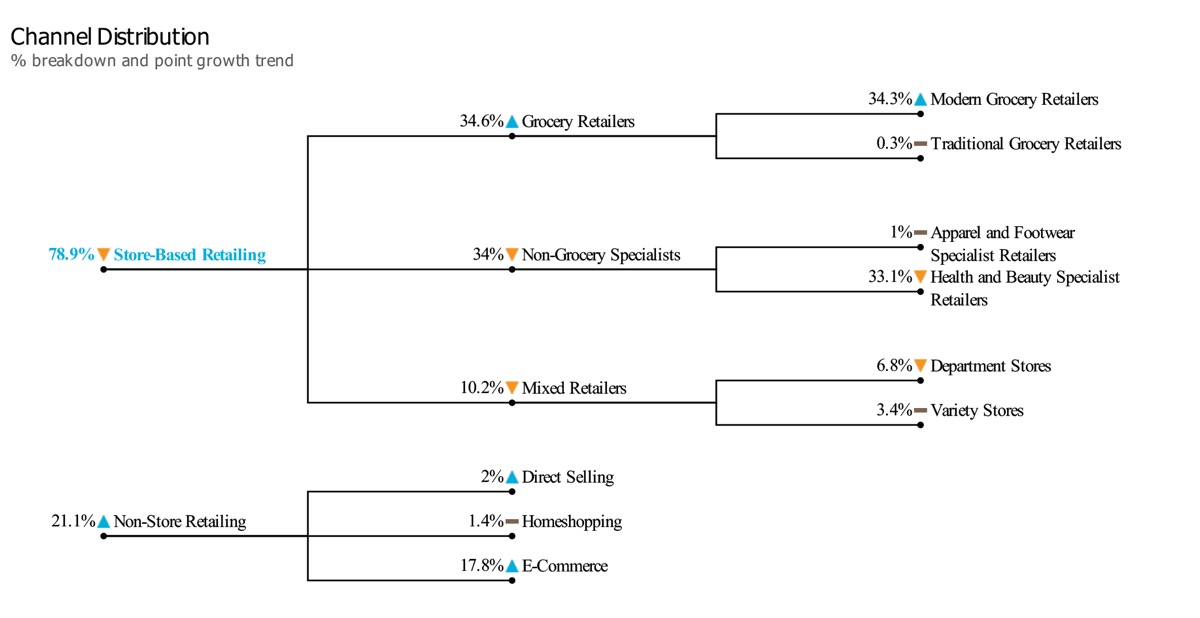
Note: The chart here showcases the retail value share of different channel sales for skin care products in the UK in 2020. The triangle/dash represents whether the specific channel share has increased/decreased or remained the same against its share in the previous year
- Market Insights
-
Market trends
- Skin care was less impacted than other categories in 2020 as its health associations and self-pampering trends buoyed the category. Face masks and body care performed particularly well. Hand care was bolstered by increased hand washing as well as increased product developments. Brands such as Vaseline were quick to relaunch their 2-in-1 hand cream with anti-bac in May 2020.
- The year 2020 also witnessed a reversion for the growth of the premium skin care category since 2010, as the financial toll of the pandemic was felt. Home seclusion in 2020 highlighted the need for digital tools in skincare for diagnostics and expert advice with brands such as Dermalogica and La Roche Posay able to leverage digital tools developed pre-pandemic to offer skin care advice and recommend products. In 2020, brands such as Kiehl’s and Deceim launched virtual consultations, with these tools also acting as a way to build consumer trust and develop a community of consumers.
- Home seclusion in 2020 and the rise of e-commerce presents a considerable advantage to digital-first players, with mainstays and heritage luxury brands having to adapt to the closure of their main distribution channels. Luxury brands have been further impacted by the lack of experiential shopping, which is a draws many consumers and cannot be achieved to the same extent online. Of the top five companies, Natura was the only one to gain share in 2020, driven by the acquisition of Avon, whose direct selling model has benefited from home seclusion, as well as strong performance from The Body Shop.
Prospects and growth opportunity
- While skin care remains relatively robust, discretionary categories such as skin care sets/kits, firming/anti-cellulite body care and the premium sector are likely to struggle over the forecast period. This is due to the economic impact of home seclusion, furlough and job losses on spending power and consumer confidence over the entire period. Face masks and general-purpose body care are expected to be buoyed by engrained self-pampering habits from periods of home seclusion. Meanwhile, facial cleansers will begin to benefit from a heightened awareness of hygiene in addition to helping as a preventative measure against so-called ‘maskne’ as the majority of consumers return to work in 2021.
- In line with the above trend, an opportunity is also expected to remain in hygiene over the forecast period to 2025, with an increased appetite for clean, single-use options such as No7 Advanced Ingredients capsules launched in March 2021. However, as consumers become increasingly concerned about the environment, biodegradable options such as Bolt Beauty will be key to success. Hygiene concerns are also set to see the continued development of antibacterial skin care after launching facial sprays by both Revolution and Beauty Kitchen in May and August 2020, respectively.
General health & wellness trends
- Skin care is set to be a major pandemic category winner as self-care gets more embedded into daily lives and associations with overall physical and emotional wellness become more prominent. In addition, increased focus on skin health has accelerated trends towards a proactive ingredients-led approach to ageing. Many consumers adopt these ingredients into their routines at a younger age. These led to launches such as Boots’ No.7 Retinol range in May 2020 and Olay’s Collagen range in January 2021.
- Over the forecast period (2020-2025), beauty and personal care companies are expected to adapt their propositions around health and wellness trends, particularly those that have been fast-tracked because of the pandemic. Also, with an anticipated recession over the forecast period, companies are expected to face an increasing number of customers who will make more informed purchasing choices around sustainability, diversity and supply chain transparency.
Dog & Cat Food
- Market size and growth
-
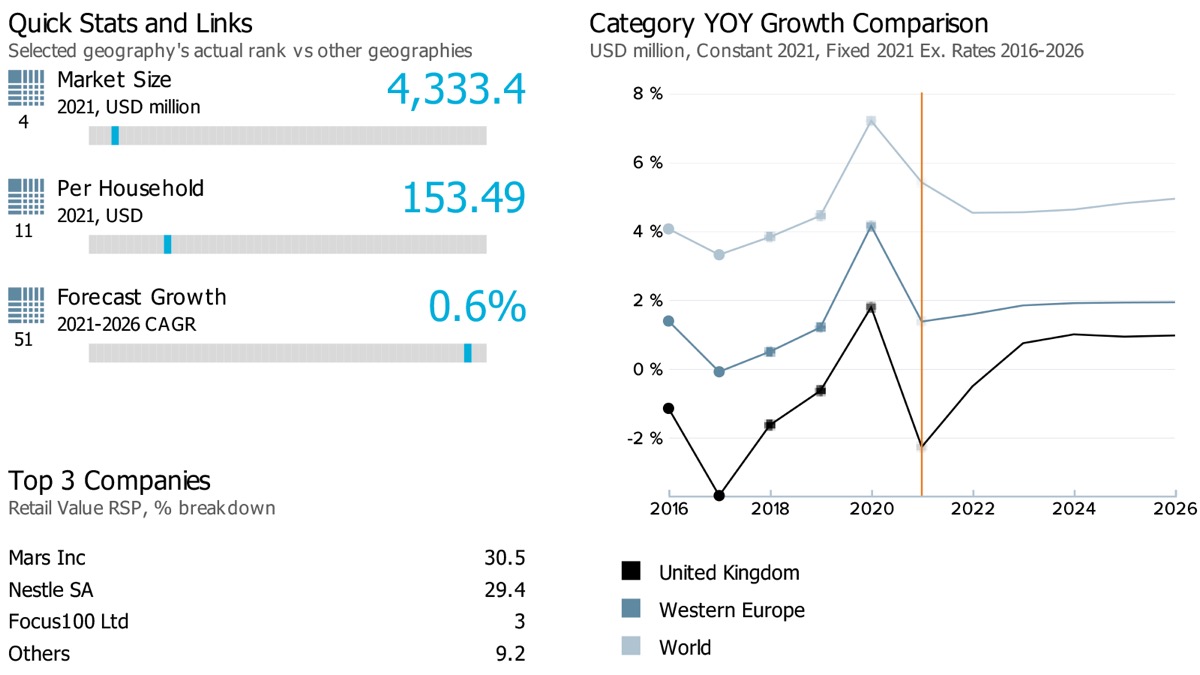
Note: Data on the top left corner of the image (4, 11, and 51) showcases respective ranks for the UK for its market size, per capita, and forecast growth rate compared against 53 countries globally. The blue line on the grey bar represents the relative position of the country as per their rank.
Note: Latest market size data for the year 2021 has been shared for Dog and Cat food
Performance of retail value sales of dog and cat food in the UK is expected to remain steady over the forecast period (2021-2026: 0.6%) against its historic compound annual growth rate (CAGR) performance (2016-2021: 0.6%). However, globally, the category is expected to witness a slowdown from a historic CAGR of 6.9% (2016-2021) to an estimated forecast CAGR of 4.7% over 2021-2026.
- Sub-category breakdown
-
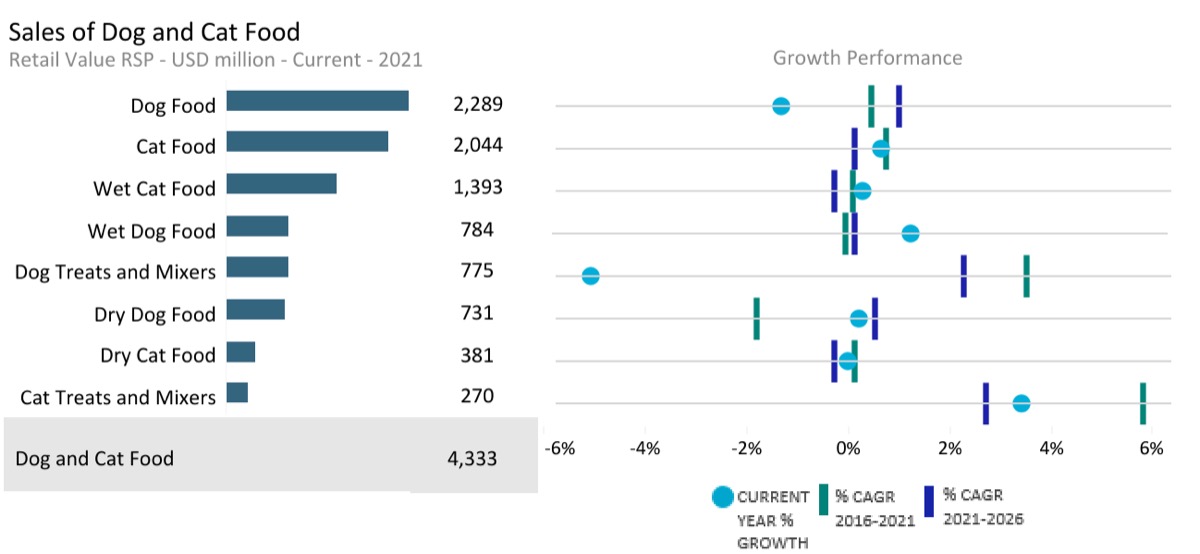
Note: Current year growth in the above chart refers to period 2020-21
Category
Unit
Market size (2021)
Retail value RSP
Forecast compound annual growth rate (2021/2026) %
Dog and Cat Food
USD million
4,333.38
0.59
Dog Food
USD million
2,289.21
0.99
Dog Treats and Mixers
USD million
774.69
2.27
Dry Dog Food
USD million
730.55
0.52
Wet Dog Food
USD million
783.98
0.13
Cat Food
USD million
2,044.16
0.15
Wet Cat Food
USD million
1,392.99
-0.27
Dry Cat Food
USD million
381.31
-0.27
Cat treats and mixers
USD million
269.86
2.74
- Channel distribution
-
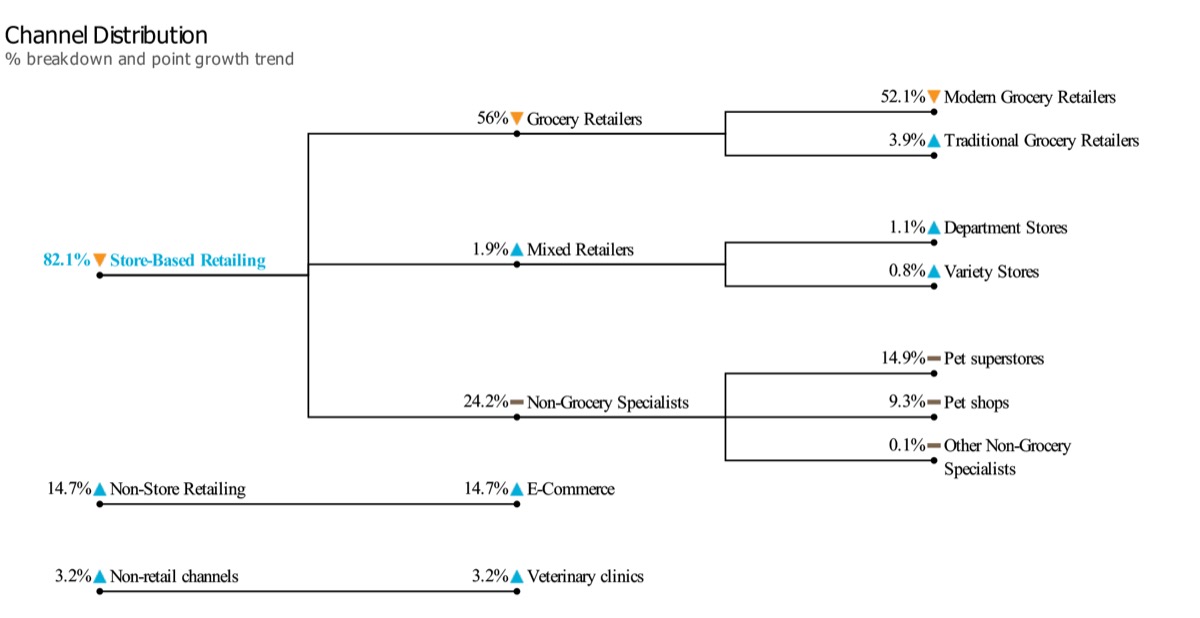
Note: The chart here showcases the retail value share of different channel sales for dog and cat food products in the UK in 2021. The triangle/dash represents whether the specific channel share has increased/decreased or remained the same against its share in the previous year.
- Market Insights
-
Market trends
- The impact of COVID-19 increased sales of pet food in 2020, with sales recording stronger growth than over the review period. This was largely due to the rising pet population. More consumers adopted a pet because they craved companionship during the long hours spent at home. With more time spent together with pets, owners wanted to develop tighter bonds and treated their pets accordingly. This, in turn, increased the demand for categories such as dog and cat treats.
- The shift towards e-commerce has also encouraged pet food manufacturers to set up their own direct-to-consumer channels. Brands such as James Wellbeloved launching a DTC service in spring 2020. Not only does this initiative enable its global owner Mars to provide consumers with its products, but it also gives it the opportunity to build more links between brands and consumers. Brands such as Lily’s Kitchen and Poppy’s Picnic already have this relationship established as part of their DNA, as they were built as online brands. As consumers shift away from buying dog food through store-based retailers, especially large bags of dry dog food, which are heavy and bulky to handle, brands are making sure they remain available and top-of-mind for consumers via online channels.
Prospects and growth opportunity
- For cat food, polarisation in demand is expected to gather momentum in value terms over the forecast period with the economy and premium segments seeing growth at the expense of the mid-priced segment. The premium price platform is expected to record the best performance in both wet and dry cat food. Premium wet cat food in pouches is particularly popular as it offers several benefits, including freshness, better portion control, convenience and the opportunity to have a selection of different flavours. Meanwhile, treats and mixers are also set to maintain a strong increase over the forecast period thanks to an increasing number of cat treats references in the market.
- Retail volume sales of dog food are set to fall throughout the forecast period as the dog population starts to fall once again. However, the rate of decline is forecast to slow over the course of the forecast period, and price rises are expected to lead to value growth across all years. As disposable incomes start to rise once again as the economic impact of the pandemic starts to fade, premiumisation is likely to be even more evident. Consumers are expected to increasingly and more willingly trade up and spend on extras for their pets and premium references.
General health & wellness trends
- Sustainability is expected to remain key in the post-COVID-19 era, and consumers are increasingly expecting premium brands to offer this attribute in their high-end dog food products. The issue is no longer only about the packaging, as with more time on their hands during home seclusion, consumers have been spending more time researching the pet food products they buy. Sustainability is expected to impact the very diets of dogs and the formulations consumers choose to purchase. For example, the Lily’s Kitchen brand launched a vegetarian dog food product containing amaranth and cottage cheese for protein; the manufacturer is advertising the product to feed less meat on “Meat Free Mondays”, which is a campaign in the human world.
- Despite several developments towards naturalness in dog food in recent years, cat food has mostly been kept away from this transformation. However, cat food is now starting to see the snowball effect of launching more natural products in dog food. For instance, to address its declining sales, in the review period (2016-2021) Purina Felix was expanded to include options such as It’s As Good As It Looks and Countryside Selection. These are marketed as more natural and healthier, claiming that they are nutritionally balanced and free from preservatives, colours and additives.
Alcoholic Drinks
- Market size and growth
-
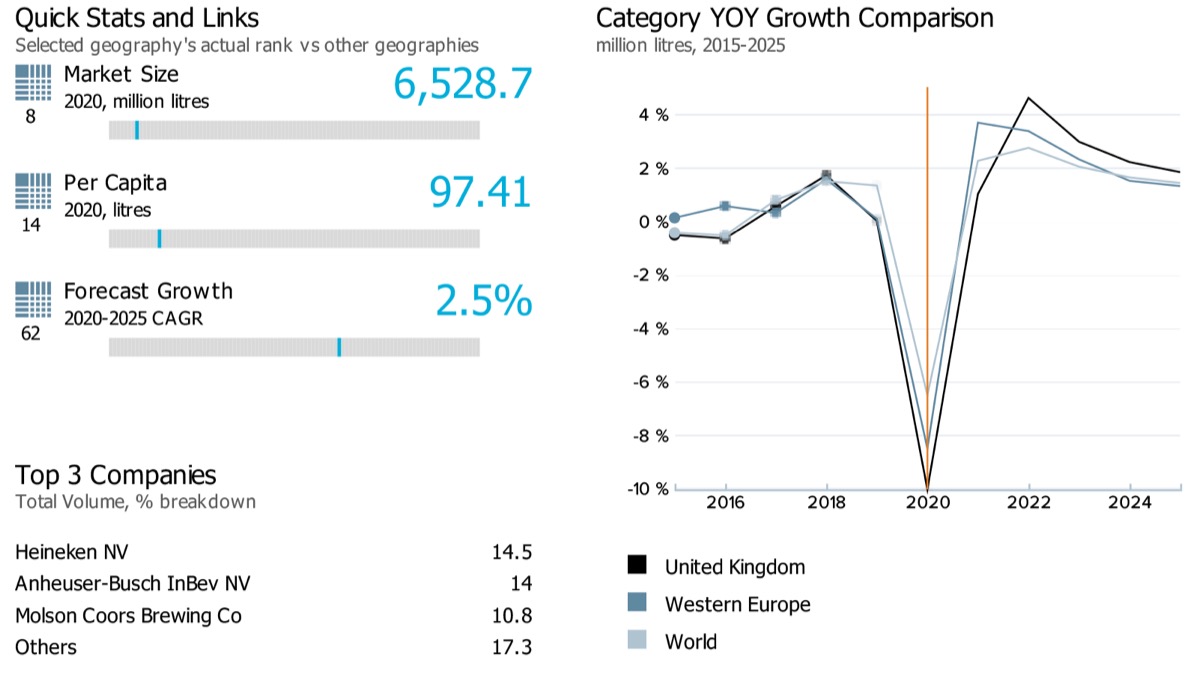
Note: Market size data for the alcoholic drinks category in the country reflects the total volume in a million litres. Data on the top left corner of the image (8, 14, and 62) showcases respective ranks for the UK for its market size, per capita, and forecast growth rate compared against 99 countries globally. The blue line on the grey bar represents the relative position of the country as per their rank.
The compound annual growth rate (CAGR) for alcoholic drinks in the UK, both in terms of total value and volume, is expected to gain momentum over the forecast period (2020-2025: FCAGR for total value: 4.9% and for total volume: 2.5% ) against its performance in the historic period (2015-2020: HCAGR for total value: -2.0% and for total volume: -1.8% ). This is mainly in line with the category’s performance at the global level, where both in terms of total value and volume, alcoholic drinks are expected to gain momentum over the forecast period (2020-2025: FCAGR for total value: 4.6% and for total volume: 2.0% ) against its performance in the historic period (2015-2020: HCAGR for total value: 0.9% and for total volume: -0.7% )
- Sub-category breakdown
-

Current year growth in the above chart refers to the period 2019-20
Category
Data type
Market size (2020)
USD million
Forecast compound annual growth rate (2020/2025) %
Alcoholic Drinks
Total Value RSP
58,645.19
4.88
Alcoholic Drinks
Off-trade Value RSP
36,053.36
-0.03
Alcoholic Drinks
On-trade Value RSP
22,591.83
11.19
Beer
Total Value RSP
22,360.99
5.68
Beer
Off-trade Value RSP
11,745.94
-0.38
Beer
On-trade Value RSP
10,615.04
11.08
Cider/Perry
Total Value RSP
3,412.83
6.37
Cider/Perry
Off-trade Value RSP
1,856.29
2.22
Cider/Perry
On-trade Value RSP
1,556.54
10.61
RTDs
Total Value RSP
1,179.79
5.20
RTDs
Off-trade Value RSP
924.72
3.27
RTDs
On-trade Value RSP
255.08
11.21
Spirits
Total Value RSP
14,648.58
5.84
Spirits
Off-trade Value RSP
8,498.41
-0.19
Spirits
On-trade Value RSP
6,150.17
12.40
Wine
Total Value RSP
17,043.01
2.53
Wine
Off-trade Value RSP
13,028.00
-0.19
Wine
On-trade Value RSP
4,015.01
9.82
- Channel distribution
-
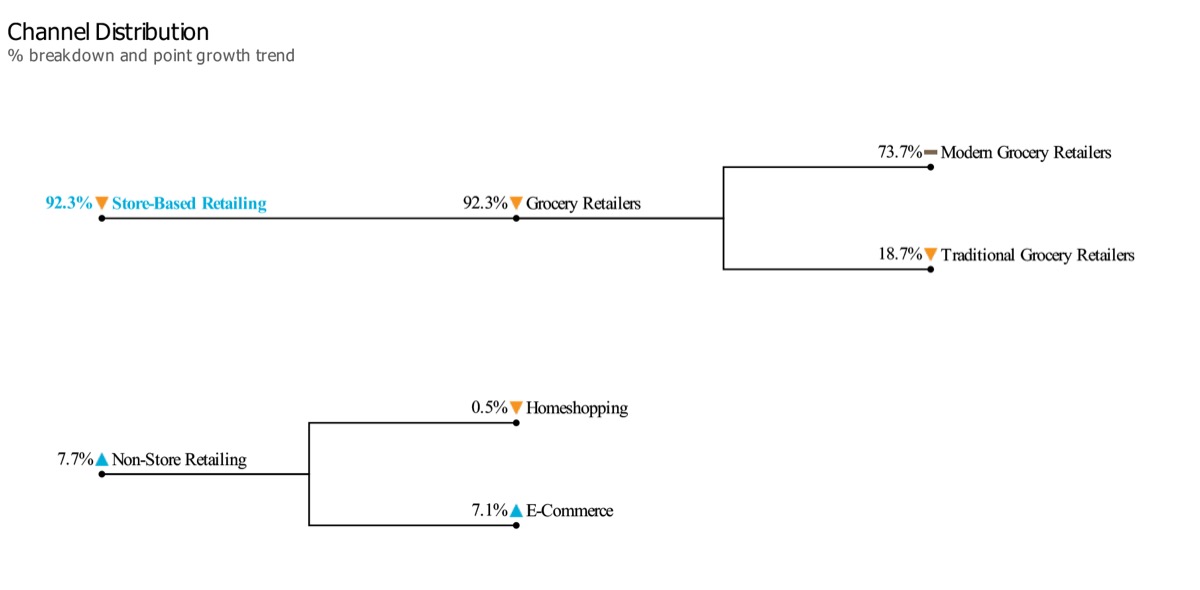
Note: The chart here showcases the off-trade volume share of different channel sales for alcoholic drink products in the UK in 2020. The triangle/dash represents whether the specific channel share has increased/decreased or remained the same against its share in the previous year.
- Market Insights
-
Market trends
- Total volume and value sales of alcoholic drinks suffered steep declines in 2020, driven by strict lockdowns to slow the spread of COVID-19 in the UK. Most on-trade premises remained closed for a large part of the year. In the short period in which the on-trade was allowed, rules were imposed by the government to limit working hours and the number of consumers that could be served, which ultimately hampered growth. However, there was a good performance of alcoholic drinks in the off-trade, with many consumers moving their consumption to the home.
- The lockdowns in 2020 played in favour of the premiumisation trend. The expansion of craft beer and microbreweries have contributed to category growth and premiumisation. As consumers were forced to spend more time at home in 2020, this accelerated the move towards premium beers as a form of self-indulgence at a difficult time. As a result, taste, provenance, and quality became stronger factors to consider when choosing which beer to drink.
- However a strong rise was seen in the consumption of flavoured spirits as well. This trend, which started in the pre-pandemic period, was further strengthened during the lockdown as a convenient alternative to cocktails. This was also evident across various categories, such as gin, vodka, rum and even whiskies.
Prospects and growth opportunity
- The lockdown in 2020 boosted the “hometainment” trend, which is expected to endure in the forecast period to 2025, as some consumers’ incomes will remain constrained, and economic off-trade purchases will therefore be favoured. As people spend more time at home, either working or socialising, new ways of consuming beer at home are likely to arise. In 2020 there were two good examples of this new trend. The Greater Good Brewing Co launched The Pinter, a machine into which the consumer places a keg, which is then fermented and purified, allowing consumers to make their fresh beer at home. A similar machine was also launched via the e-commerce channel by Beer Hawk, named Perfect Bundle. Besides these machines, sales of beer cases, which can also be found on Beer Hawk’s website, are also likely to become more common in the coming years.
- Sustainability is expected to become more important than ever in spirits in the forecast period, as COVID-19 has raised awareness of such issues. Consumers are increasingly becoming aware of environmental issues and are paying more attention to the damage certain products cause to the environment. Therefore, they want the brands they consume to be sustainable and locally produced. The rise of organic and natural ingredients are expected, and brands will embrace production processes that are sustainable and environmentally friendly. The 2020 launches of Nàdar Gin, the world’s first climate-positive gin, Nc’nean’s organic and sustainably packaged single malt whisky, and Absolut’s new paper bottle are just a few examples of what is expected to emerge in 2021 and beyond.
General industry trends
- Rising from a low base, a boom in non-alcoholic spirits is expected over the forecast period. Its increase will align with the health and wellness trend, which is likely to become more prominent over the coming years, accelerated by COVID-19. Non-alcoholic spirits will target consumers who are regular drinkers and want to moderate their alcohol intake and new groups of consumers who are not allowed to consume alcohol, either for age, health or religious reasons, for instance. Non-alcoholic spirits have mostly been launched by smaller distilleries and brands, such as the launch of KVÎST’s two new variants in 2020.
- Similarly, consumers demand non/low alcohol wine is also increasing as consumers’ attitudes towards alcohol continue to change. COVID-19 led many consumers to become even more conscious of and concerned about their health. This is likely to lead to interesting innovations in the non/low alcohol space in wine. With such products, it is often hard to get a good taste to appeal to consumers’ palettes, which is where efforts are likely to be focused. The increasing number of adults drinking less or completely abstaining from alcohol, driven by health concerns, will lead operators to innovate through their non/low alcohol wine offerings. Tesco and Aldi have already broadened their non/low alcohol wine selections and are working on improving the quality of these products.
Health & Wellness Packaged Food & Beverages
- Market size and growth
-
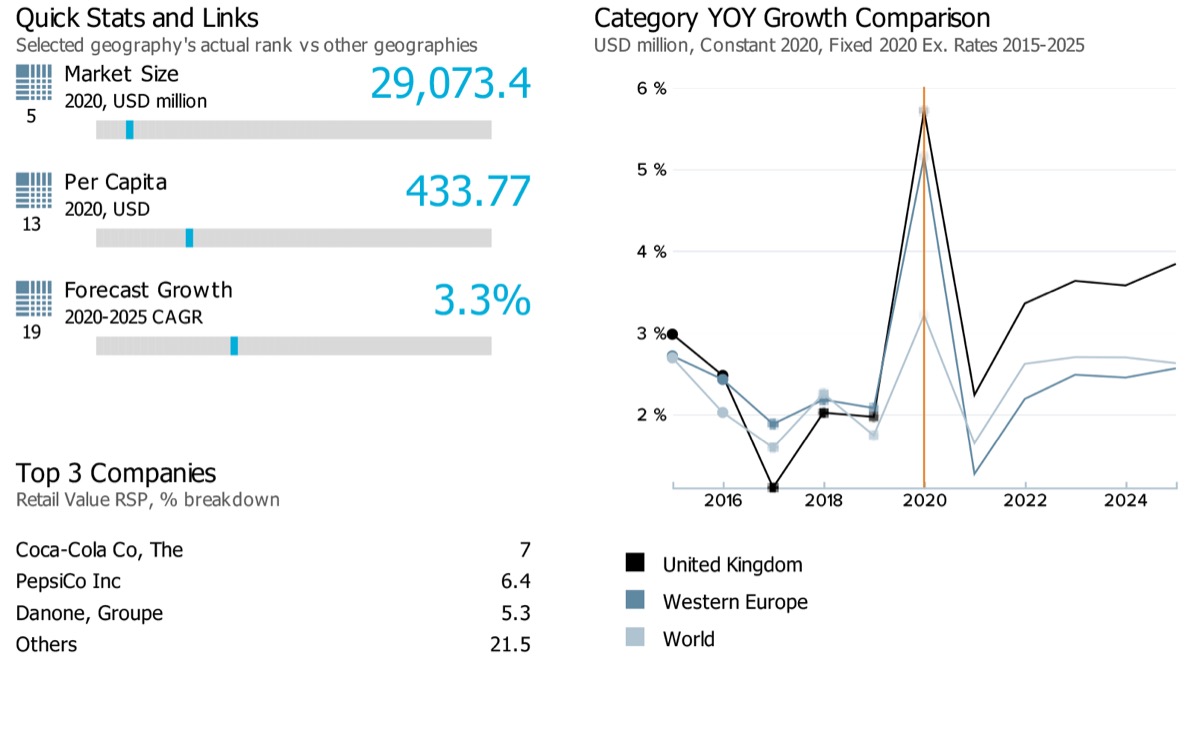
Note: Data on the top left corner of the image (5, 13, and 19) showcases respective ranks for the UK for its market size, per capita, and forecast growth rate compared against 53 countries globally. The blue line on the grey bar represents the relative position of the country as per their rank.
The UK's retail value sales of health and wellness food and beverage products are expected to slow down when comparing the compound annual growth rates from historic to forecast periods, i.e. (4.4% during 2015-2020 to 3.3% during 2020-2025). This was also the case with the category’s performance at the global level, where its compound annual growth rate for retail value sales is estimated to slow down from 4.6% during 2015-2020 to 2.4% during 2020-2025.
- Sub-category breakdown
-
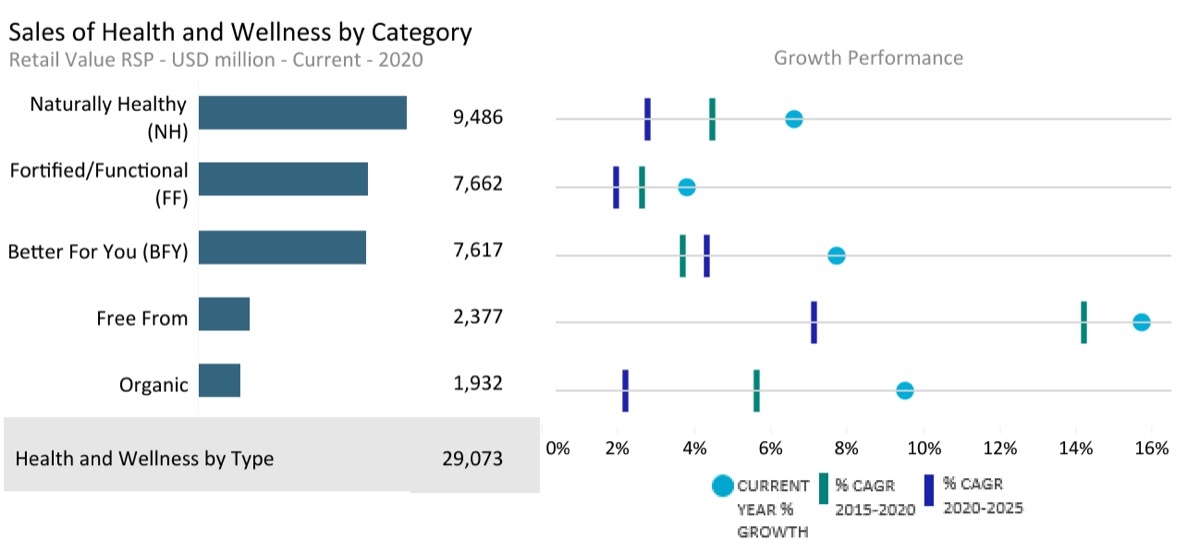
Current year growth in the above chart refers to the period 2019-20
Category
Unit
Market size (2020)
Retail value RSP
Forecast compound annual growth rate (2020/2025) %
Health and Wellness by Type
USD million
29,073.37
3.32
Better For You (BFY)
USD million
7,616.65
4.33
Fortified/Functional (FF)
USD million
7,661.73
1.94
Free From
USD million
2,376.64
7.12
Naturally Healthy (NH)
USD million
9,486.15
2.77
Organic
USD million
1,932.19
2.21
- Channel distribution
-
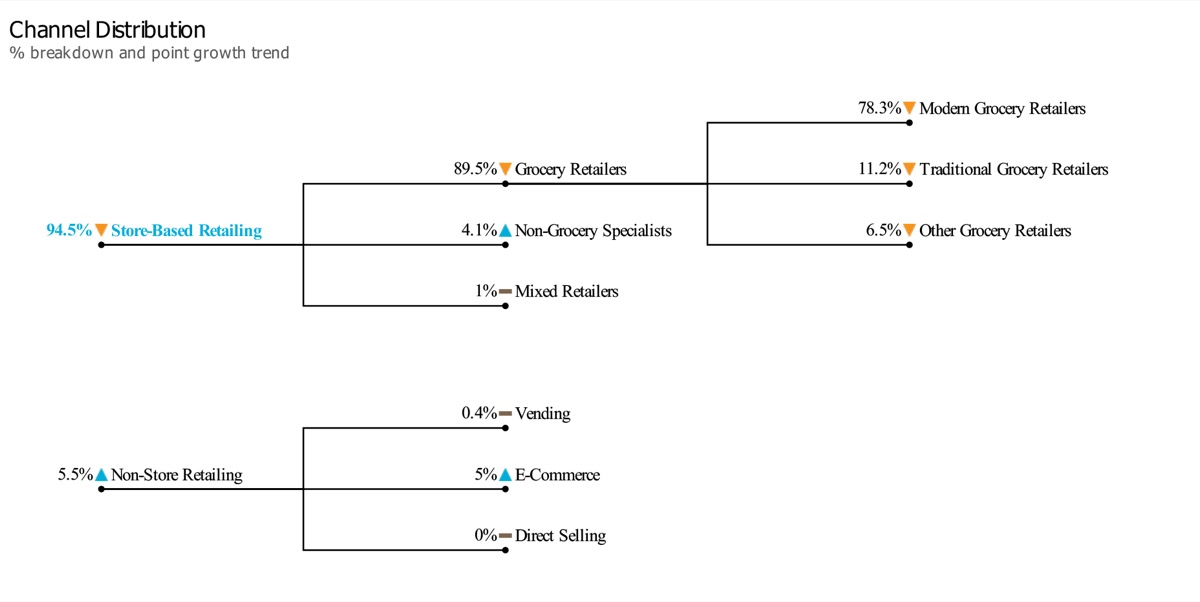
Note: The chart here showcases the retail value share of different channel sales for health and wellness by type products in the UK in 2020. The triangle/dash represents whether the specific channel share has increased/decreased or remained the same against its share in the previous year.
- Market Insights
-
Market trends
- Health and wellness products have performed well during the COVID-19 crisis in the UK, with a growing number of consumers looking to boost their immune systems with added vitamins or by reducing sugar intake. However, on-trade sales have been dramatically impacted in the country. In on-trade establishments, health and wellness products tend to be served in independent cafés, which have been most affected by restrictions as they cannot resist financially compared to larger companies with more cash and capital reserves.
- Demand for FF (fortified/functional) beverages have witnessed mixed reactions because of COVID-19 pandemic. On one hand we have a growing number of consumers seeking beverages with functional properties that can boost their immune system. On the other hand, given most sales continue to be made in HORECA (hotel/restaurant/café) outlets, demand was negatively impacted by high unit prices and lost consumption occasions. This trend is set to continue as working from home is now the norm for many companies, and office workers are no longer purchasing on-the-go drinks while staying at home.
- Flavoured bottled water is one of the most popular alternatives to carbonates amongst consumers in the UK. Such beverages offer a fruity, refreshing moment without calories or sugar. In 2020, NH (naturally healthy) carbonated water performed particularly strongly due to the mixology trend and the willingness of consumers to reproduce an on-trade experience at home given the closure of HORECA outlets.
Prospects and growth opportunity
- Clean labels and simple ingredients will remain key to attracting consumers to Naturally healthy packaged food. Time-constrained consumers appreciate easy-to-understand and clear ingredients lists that highlight the health benefits of products. As demand for clean labels increases, manufacturers are expected to put their claims on the front of packs to reduce the time needed for consumers to understand the benefits of their products.
- Beverages with health claims face continued scrutiny from the advertising authorities, with functional benefits prohibited from being highlighted on product packs and specific wording removed from marketing content. As a result, manufacturers must educate consumers about the health benefits of their product ingredients while complying with more stringent labelling regulations. This has resulted in companies investing in fruit flavours and botanical ingredients to convey a sense of “health” in their new product developments. Naturally healthy beverages already strongly resonate with wellness and thus have the opportunity to continue witnessing growth through retail channels over the coming years.
General health & wellness trends
- Overall, the trend towards health and wellness beverages will continue to grow over the coming years to 2025 as strong consumer health awareness is further boosted by the desire to boost the immune system in response to the COVID-19 pandemic. Furthermore, introducing a growing array of new innovative products will also help boost sales and attract new consumers, with reduced sugar beverages set to perform particularly well. The entry of larger players within organic beverages will also help to develop the overall market.
- Sales of NH fruit and nut bars, NH nuts, seeds and trail mixes and high fibre sweet biscuits will continue to grow over the coming years. These products benefit from the snacking trend as they are considered healthy alternatives to other snacks, such as confectionery and crisps. Nuts, seeds and trail mixes are also a great source of healthy fats and protein, which is important to the increasing number of consumers following vegetarian and plant-based diets. Therefore, these products are often positioned next to the checkout in stores, targeting consumers looking for a healthy snack. The natural aspect of NH packaged food is the main selling point of these products, and this will continue over the forecast period to 2025.
Retail Landscape
- Brand shares of supermarkets
-
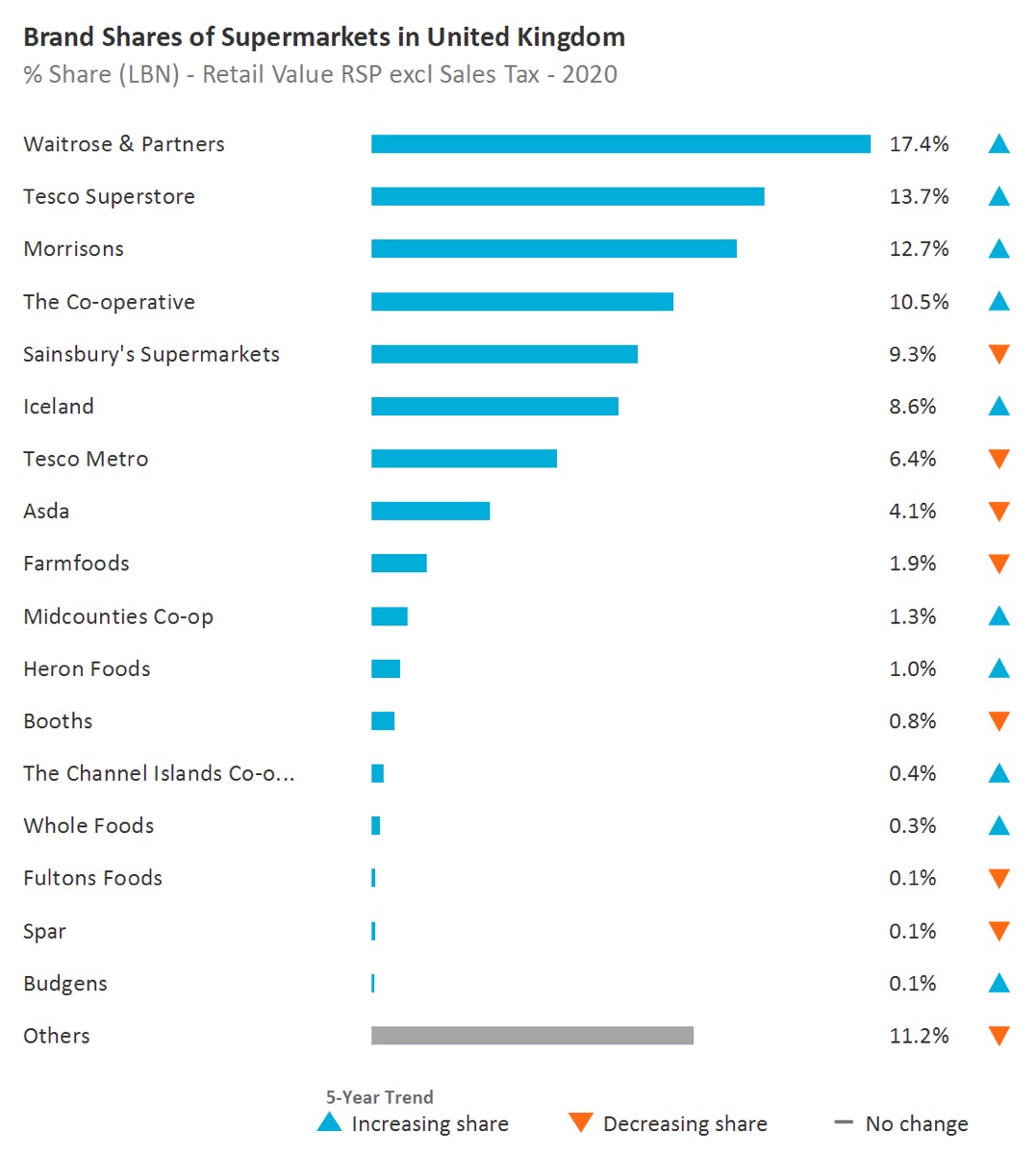
Note: The 13th supermarket in the above chart is – The Channel Islands Co-operative.
- Brand shares of chemists/pharmacies
-
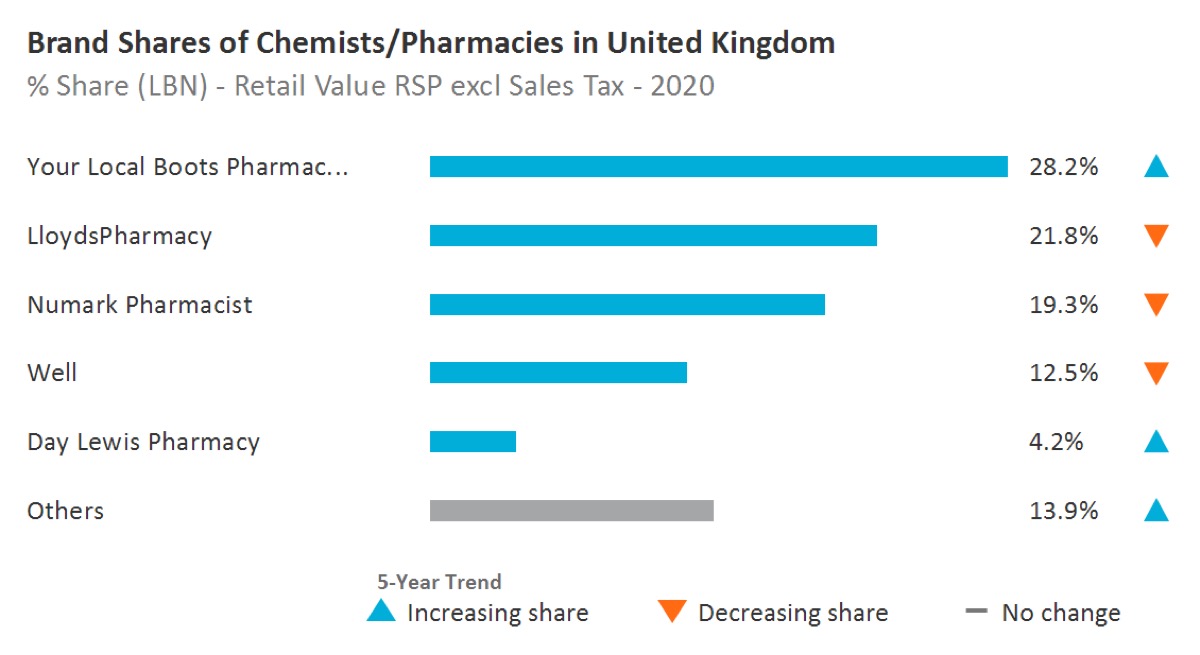
Note: The 1st chemist/pharmacies in the above chart is – Your Local Boots Pharmacy
- Retail insights
-
- In contrast to the general global trend where in-store grocery retailing channels suffered due to the rise of online grocery shopping, supermarkets were amongst the strongest performers in terms of store-based retailers in the UK in 2020. While pre-pandemic consumers favoured smaller and more frequent purchases, 2020 saw consumers opting for fewer store visits but bigger basket sizes during this period. Although the pandemic positively impacted supermarkets’ performance, the surge in online shopping will likely pose a strong competition to supermarkets over the forecast period, in terms of also gaining share from this channel.
- The pandemic is expected to result in long-term changes to retailing in the UK. Such changes include the permanent shift to omnichannel operations, the increased focus on in-store experiences and the emergence of pop-up stores or store relocations to suburban areas. The accelerating e-commerce trend, combined with the struggle of the British high street in previous years, will increasingly encourage traditional bricks-and-mortar retailers to focus on building a multichannel presence by blurring the line between in-store and online operations. Having an online presence as part of an omnichannel strategy will remain a key priority for retailers. Therefore, store-based retailing, especially in the non-grocery channels, will see the emergence of new store formats.
- An engaging in-store shopping experience has been at the forefront of grocery shopping for the consumers in the UK over the review period from 2020-2025, with a specific focus on improving in-store payments. Due to the pandemic, and thus, contact-free shopping and checkout are more relevant than ever for health-related reasons. With the increasing demand for online grocery shopping, retailers also need to enhance the online shopping and payment experience and the services they offer, such as click-and-collect and home delivery.
- For 2020, the market size of chemists/pharmacies in the country was USD 7,389.8 million (Retail value RSP without sales tax). The channel experienced a 0.1% year-over-year growth rate in 2020-2021. Over the past five years (2015-2020), the value compound annual growth rate has been recorded as -0.1%. However, the channel's retail value compound annual growth rate is predicted to improve to 2.1% over the forecast period (2020-2025).
- Definitions
- Acronyms Used & Key Notes
Definitions
|
Industry |
Category |
Definition |
|---|---|---|
|
Alcoholic Drinks |
Alcoholic Drinks |
Alcoholic drinks are the aggregation of beer, wine, spirits, cider/perry and RTDs. |
|
Alcoholic Drinks |
Beer |
An alcoholic drink usually brewed from malt, sugar, hops and water and fermented with yeast. Some beers are made by fermenting a cereal, especially barley, and therefore not flavoured by hops. Alcohol content for beer is varied – anything up to and over 14% ABV (alcohol by volume), although 3.5% to 5% is most common. Beer is the aggregation of lager, dark beer, stout and non/low alcohol beer. |
|
Alcoholic Drinks |
Cider/Perry |
Cider is made from fermented apple juice while perry is made from fermented pear juice. Both artisanal and industrial cider/perry are included. |
|
Alcoholic Drinks |
RTDs |
RTD stands for ‘ready-to-drink’. Other terms which may be used for these products are FABs, alcopops and premixes. The RTDs sector is the aggregation of malt-, wine-, spirit- and other types of premixed drinks. These drinks usually have an alcohol content of around 5% but this can reach as high as 10% ABV. Premixes containing a high percentage of alcohol of around 15%+ combined with juice or any other soft drink are included here. RTDs are usually marketed as products to be drunk neat, with ice, or as a cocktail ingredient. Fruit-flavoured, vodka-based spirits with an alcohol content of between 16-21% are classified here. Examples: Alizé, Ursus Roter, Berentzen Fruchtige, Kleiner Feigling. |
|
Alcoholic Drinks |
Spirits |
This is the aggregation of whisk(e)y, brandy and Cognac, white spirits, rum, tequila, liqueurs and other spirits. |
|
Alcoholic Drinks |
Wine |
This is the aggregation of still and sparkling light grape wines, fortified wine and vermouth and non-grape wine. In terms of alcohol content, light wine usually falls into the 8-14% ABV bracket while fortified wine ranges from 14-23% ABV. Low and non-alcoholic wine is also included in the data (attributed to each sector as appropriate). |
|
Beauty and Personal Care |
Skin Care |
This is the aggregation of facial care, body care, hand care and skin care sets/kits. |
|
Beauty and Personal Care |
Body Care |
This is the aggregation of firming/anti-cellulite products and general-purpose body care. |
|
Beauty and Personal Care |
Facial Care |
This is the aggregation of acne treatments, moisturisers and treatments, facial cleansers, toners, face masks, and lip care. Please note that Moisturisers and Treatments is the aggregation of basic moisturisers and anti-agers. |
|
Beauty and Personal Care |
Hand Care |
Includes all hand moisturisers, both premium and mass market, as well as combination hand and nail products. Includes protective emollients and deep moisturisers formulated to sooth and hydrate very dry or irritated skin, as well as those that prevent, or that are suitable for, eczema-prone or redness-prone skin. Excludes medicated emollients and/or those positioned as treatment for eczema or psoriasis. |
|
Beauty and Personal Care |
Skin Care Sets/Kits |
Multiple skin care items of the same brand line packaged together in a set and priced at an advantageous price compared to purchasing the items separately. Includes traditional gift sets, multi-step skin care regimens, skin care starter kits (including acne treatment regimen sets/kits) and skin care travel kits (sold through retail outlets). Also includes sets, which comprise of products from multiple categories (e.g. makeup and skin care), as long as the primary product is skin care. Men’s, women’s and unisex versions are included. Excludes: GWP (Gift with Purchase) – consumer does not pay for this (e.g. free product when you purchase a set or a free sample kit). |
|
Consumer Health |
Dietary Supplements |
It is the aggregation of all dietary supplements: Minerals, fish oils/omega fatty acids, garlic, ginseng, ginkgo biloba, evening primrose oil, Echinacea, St John's Wort, protein supplements, probiotic supplements, eye health supplements, co-enzyme Q10, glucosamine, combination herbal/traditional supplements, non-herbal/traditional supplements, and all other dietary supplements specific to country coverage. |
|
Consumer Health |
Paediatric Vitamins and Dietary Supplements |
All vitamin and dietary supplement products formulated, designed, marketed and labelled specifically for children. |
|
Consumer Health |
Tonics |
Include versions of combination dietary supplements that are sold in the format of liquid concentrates, mini-drinks, shots or oral gels. Include concentrated energy shot boosters and tonics such as 5-Hour Energy and Lipovitan. Exclude remedies made with active pharmaceutical ingredients as well as super fruit juice concentrates and weight-loss beverages, tracked under the Health and Wellness (HW) system. |
|
Consumer Health |
Vitamins |
This is the aggregation of multivitamins and single vitamins. |
|
Health and Wellness |
Health and Wellness by Type |
Health and Wellness by Type is the aggregation of all health and wellness food and beverages broken down by organic, fortified/functional, naturally healthy, better for you and free from products. |
|
Health and Wellness |
Better For You (BFY) |
Products where the amount of a substance considered to be less healthy (eg fat, sugar, salt, carbohydrates) has been actively reduced during production. To qualify for inclusion in this category, the “less healthy” element of the foodstuff needs to have been actively removed or substituted during the processing. This should also form a key part of the positioning/marketing of the product. Products which are naturally fat/sugar/carbohydrate -free are not included as nothing out of the ordinary has been done during their production to make them “better for you”. “No added sugar” claims are excluded too. Products most likely to be included here will be those which are low-fat/low-sugar versions of standard products (i.e. reduced fat mayonnaise, reduced fat cheese, reduced fat milk, reduced sugar confectionery, etc). |
|
Health and Wellness |
Fortified/Functional (FF) |
This category includes fortified/functional food and beverages. When identifying fortified/functional products, we focus on products to which health ingredients or/and nutrients have been added as well as brands that are positioned to deliver a certain functionality. To be included here the enhancement must be highlighted in the label or hold a health claim/nutritional claim. Fortified/functional food and beverages provide health benefits beyond their nutritional value and/or the level of added ingredients wouldn’t normally be found in that product. To merit inclusion in this category, the defining criterion here is that the product must have been actively fortified/enhanced during production. As such, inherently healthy products such as 100% fruit/vegetable juices are only included under "fortified/functional" if additional health ingredients (e.g. calcium, omega 3) have been added. To be included, the health benefit needs to form part of positioning/marketing of the product. For product category definitions please refer to the definitions section (can be found under the "Help" section on Passport) for the respective system: Packaged Food, Hot Drinks, Soft Drinks. |
|
Health and Wellness |
Free From |
This category includes free from gluten, free from lactose, free from allergens, free from dairy and free from meat products. This excludes foods which are certified ‘free’ of a specific product when this is based on use of sterilised equipment. |
|
Health and Wellness |
Naturally Healthy (NH) |
This category includes food and beverages based on naturally containing a substance that improves health and wellbeing beyond the product’s pure calorific value. These products are usually a healthier alternative within a certain sector/subsector. High fibre food (wholegrain/wholemeal/brown), soy products, sour milk drinks, nuts, seeds and trail mixes, honey, fruit and nut bars and olive oil are considered NH foods and 100% fruit/vegetable juice, superfruit juice, natural mineral water, spring water, RTD green tea etc. are considered NH beverages. While many of these products are marketed on a health basis, this might not always be the case. Naturally healthy food and beverages that are additionally fortified fall into the 'fortified/functional' category. |
|
Health and Wellness |
Organic |
Certified organic products are those which have been produced, stored, processed, handled and marketed in accordance with precise technical specifications (standards) and certified as "organic" by a certification body such as the Soil Association in the UK, the European Union or the US Department of Agriculture. It is important to note that an organic label applies to the production process, ensuring that the product has been produced and processed in an ecologically sound manner. The organic label is therefore a production process claim as opposed to a product quality claim. Note: For organic products to be included, the organic aspect needs to form a significant part of the overall positioning/marketing of the product, including the organic certification label in the packaging. |
|
Pet Care |
Dog and Cat Food |
This is the aggregation of dog and cat food. |
|
Pet Care |
Cat Food |
This is the aggregation of wet and dry cat food. |
|
Pet Care |
Cat Treats and Mixers |
This is the aggregation of mixers and treats for cats. |
|
Pet Care |
Dry Cat Food |
These products have a moisture content of 10-14% and are generally packed into paper, plastic or cardboard. Dry cat food is typically made from a combination of grain-based ingredients (corn and rice) and a meat component. It is typically produced by extrusion cooking under high heat and pressure and then sprayed with fat to increase palatability. Other ingredients may also be added to complete its composition. This is the aggregation of premium, mid-priced and economy dry cat food. Note: semi-moist food is included here. These products are extruded (combining meat and cereal), have a higher moisture content (20-40%) and are usually packaged in plastic or foil sachets. |
|
Pet Care |
Wet Cat Food |
These products have a moisture content of 60-85% and are generally (though not always) preserved by heat treatment. They are packaged in steel or aluminium cans, rigid or flexible plastic or semi-rigid aluminium trays. This is the aggregation of premium, mid-priced and economy wet cat food. |
|
Pet Care |
Dog Food |
This is the aggregation of wet and dry dog food. |
|
Pet Care |
Dog Treats and Mixers |
This is the aggregation of mixers and treats for dogs. |
|
Pet Care |
Dry Dog Food |
These products generally have a moisture content of 6-14% and are generally packed into paper, plastic or cardboard. Complete dry dog foods fall into two broad categories: Flaked (or 'Muesli' type blended products) and Extruded products (meat and cereals cooked by direct steaming). This is the aggregation of premium, mid-priced and economy dry dog food. Note: semi-moist food is included here. These products are extruded (combining meat and cereal) have a higher moisture content (20-40%) and are usually packaged in plastic or foil sachets. |
|
Pet Care |
Wet Dog Food |
These products have a moisture content of 60-85% and are generally (though not always) preserved by heat treatment. They are packaged in steel or aluminium cans, rigid or flexible plastic or semi-rigid aluminium trays. This is the aggregation of premium, mid-priced and economy wet dog food. |
|
Retail in Alcoholic Drinks |
Store-Based Retailing |
Store-based retailing is the aggregation of grocery retailers and non-grocery specialists and mixed retailers. |
|
Retail in Alcoholic Drinks |
Grocery Retailers |
Retailers selling predominantly food/beverages/tobacco and other everyday groceries. This is the aggregation of hypermarkets, supermarkets, discounters, convenience stores, independent small grocers, forecourt retailers, food/drink/tobacco specialists and other grocery retailers. |
|
Retail in Alcoholic Drinks |
Convenience Stores |
Chained grocery retail outlets selling a wide range of groceries and fitting several of the following characteristics: Extended opening hours •Selling area of less than 400 sq. metres •Located in residential neighbourhoods •Handling two or more of the following product categories: audio-visual goods (for sale or rent), foodservice (prepared take-away, made-to-order, and hot foods), newspapers or magazines, cut flowers or pot plants, greetings cards, automotive accessories. Example brands include 7-Eleven, Spar. |
|
Retail in Alcoholic Drinks |
Discounters |
Discounters are retail outlets typically with a selling space of between 400 and 2,500 square metres. Retailers' primary focus is on selling private label products within a limited range of food/beverages/tobacco and other groceries at budget prices. Discounters may also sell a selection of non-groceries, frequently as short-term special offers. Discounters can be classified as hard discounters and soft discounters. Hard discounter: first introduced by Aldi in Germany, and also known as limited-line discounters. Retail outlets, typically of 300-900 square metres, stocking fewer than 1,000 product lines, largely in packaged groceries. Goods are mainly private-label or budget brands. Soft discounter: usually slightly larger than hard discounters, and also known as extended-range discounters. Retail outlets typically stocking 1,000-4,000 product lines. As well as private-label and budget brands, stores commonly carry leading brands at discounted prices. Discounters excludes mass merchandisers and warehouse clubs. Example brands include Aldi, Lidl, Plus, Penny, Netto. |
|
Retail in Alcoholic Drinks |
Forecourt Retailers |
Grocery retail outlets selling a wide range of groceries from a gas station forecourt and fitting several of the following characteristics: • Extended opening hours • Selling area of less than 400 sq. metres • Handling two or more of the following product categories: audio-visual goods (for sale or rent), take-away food (readymade sandwiches, rolls or hot food), newspapers or magazines, cut flowers or pot plants, greetings cards, automotive accessories. Example brands include BP Connect, Shell Select. Forecourt retailers includes both chained forecourt retailers and independent forecourt retailers. |
|
Retail in Alcoholic Drinks |
Hypermarkets |
Hypermarkets are retail outlets with a selling space of over 2,500 square metres and with a primary focus on selling food/beverages/tobacco and other groceries. Hypermarkets also sell a range of non-grocery merchandise. Hypermarkets are frequently located on out-of-town sites or as the anchor store in a shopping centre. Example brands include Carrefour, Tesco Extra, Géant, E Leclerc, Intermarché, Auchan. Excludes cash and carry, warehouse clubs and mass merchandisers. |
|
Retail in Alcoholic Drinks |
Supermarkets |
Retail outlets selling groceries with a selling space of between 400 and 2,500 square metres. Excludes discounters, convenience stores and independent grocery stores. Example brands include Champion, Tesco, Casino. |
|
Retail in Alcoholic Drinks |
Food/drink/tobacco specialists |
Retail outlets specialising in the sale of mainly one category of food, drinks store and tobacconists. Includes bakers (bread and flour confectionery), butchers (meat and meat products), fishmongers (fish and seafood), greengrocers (fruit and vegetables), drinks stores (alcoholic and non-alcoholic drinks), tobacconists (tobacco products and smokers’ accessories), cheesemongers, chocolatiers and other single food categories. Alcoholic drinks stores are retail outlets with a primary focus on selling beer/wine/spirits/other alcoholic beverages. Example brands include: Threshers, Gall & Gall, Liquorland, Watson’s Wine Cellar |
|
Retail in Alcoholic Drinks |
Independent Small Grocers |
Retail outlets selling a wide range of predominantly grocery products. These outlets are usually not chained and if chained will have fewer than 10 retail outlets. Mainly family owned, often referred to as Mom and Pop stores. |
|
Retail in Alcoholic Drinks |
Other Grocery Retailers |
Other retailers selling predominantly food, beverages and tobacco or a combination of these. Includes kiosks, markets selling predominantly groceries. Includes CTNs and health food stores, Food & drink souvenir stores and regional speciality stores. Direct home delivery, eg of milk, meat from farm/dairy is excluded. Sari-Sari stores in Philippines and Warung (Waroon) in Indonesia, that can either be markets or kiosks, are included in Other grocery retailers unless they occupy a separate permanent outlet building, in which case they are included in Independent small grocers. Outlets located within wet markets, particularly in South East Asia (often located in government-owned multi-story buildings) should be counted as separate outlets. Wine sales from Vineyards are included here. |
|
Retail in Alcoholic Drinks |
Non-Grocery Specialists |
Retail outlets selling predominantly non-grocery consumer goods. Non-grocery retailers is the aggregation of: • Apparel and footwear specialist retailers • Electronics and appliance specialist retailers • Health & beauty specialist retailers • Home and garden specialist retailers • Leisure and personal goods specialist retailers • Other non-grocery retailers |
|
Retail in Alcoholic Drinks |
Drugstores/parapharmacies |
Retail outlets selling mainly OTC healthcare, cosmetics and toiletries, disposable paper products, household care products and other general merchandise. Such outlets may also offer prescription-bound medicines under the supervision of a pharmacist. Drugstores in Spain (Droguerias) also sell household cleaning agents, paint, DIY products and sometimes pet products and services such as photo processing. Example brands include Rossmann (Germany), Kruidvat (Netherlands), Walgreen’s (US), CVS (US), Medicine Shoppe (US), Matsumoto Kiyoshi (Japan), HAC Kimisawa (Japan). |
|
Retail in Alcoholic Drinks |
Mixed Retailers |
This is the aggregation of department stores, variety stores, mass merchandisers and warehouse clubs. |
|
Retail in Alcoholic Drinks |
Department Stores |
Outlets selling mainly non-grocery merchandise and at least five lines in different departments, usually with a sales area of over 2,500 sq metres. They are usually arranged over several floors. Example brands include Macy’s, Bloomingdale’s, Marks & Spencer, Harrods, Sears, JC Penney, Takashimaya, Mitsukoshi, Daimaru, Karstadt, Rinascente. |
|
Retail in Alcoholic Drinks |
Mass Merchandisers |
Mixed retail outlets that usually: (1) convey the image of a high-volume, fast-turnover outlet selling a variety of merchandise for less than conventional prices; (2) provide centralised check-out service; and (3) provide minimal customer assistance within each department. Example brands include Wal-Mart, Target and Kmart. Excludes hypermarkets and warehouse clubs/cash and carry stores. |
|
Retail in Alcoholic Drinks |
Variety Stores |
Non-grocery general merchandise outlets usually located on one floor, offering a wide assortment of extensively discounted fast-moving consumer goods on a self-service basis. Normally over 1,500 sq. metres in size, except in the case of dollar stores, these outlets give priority to fast-moving non-grocery items that have long shelf-lives. Includes catalogue showrooms and dollar stores. Example brands include Woolworth (Germany), Upim (Italy). |
|
Retail in Alcoholic Drinks |
Warehouse Clubs |
Warehouse Clubs are chained outlets that sell a wide variety of merchandise but do have a strong mix of both grocery and non-grocery products. Customers have to pay an annual membership fee in order to shop. The clubs are able to keep prices low due to the no-frills format of the stores and attempt to drive volume sales through aggressive pricing techniques. Warehouse Clubs typically: - exceed 2,500 sq. metres of selling space and are invariably -over 4,000 sq. metres in size; - convey the image of a high-volume, fast-turnover retailing at less than conventional prices; - provide minimal customer assistance within each department; and - are situated in out-of-town locations. Example brands include: - Costco - Sam’s Club (Wal-Mart) - PriceSmart - Cost-U-Less |
|
Retail in Alcoholic Drinks |
Non-Store Retailing |
The retail sale of new and used goods to the general public for personal or household consumption from locations other than retail outlets or market stalls. Non-store retailing is the aggregation of Vending, Direct Selling, Homeshopping and Internet Retailing. |
|
Retail in Alcoholic Drinks |
Direct Selling |
Direct selling is the marketing of consumer goods directly to consumers, generally in their homes or the homes of others, at their workplace and other places away from permanent retail locations. Direct selling occurs in two primary ways: one-to-one basis (usually by prior arrangement a demonstration is given by a direct seller to a customer) or party-plan basis (selling through explanation and demonstration of products to a group of prospective customers by a direct seller usually in the home of a host(ess) who invites other persons for this purpose). |
|
Retail in Alcoholic Drinks |
Homeshopping |
Homeshopping is the sale of consumer goods to the general public via mail order catalogues, TV shopping and direct mail. Consumers purchase goods in direct response to an advertisement or promotion through a mail item, printed catalogue, TV shopping programme, or Internet catalogue whereby the order is placed, and payment is made by phone, by post or through other media such as digital TV. Excludes sales on returned products/unpaid invoices. Excludes sales ordered and paid online which are instead included within Internet retailing. |
|
Retail in Alcoholic Drinks |
E-Commerce |
Sales of consumer goods to the general public via the Internet. Please note that this includes sales through mobile phones and tablets. Internet retailing includes sales generated through pure e-commerce web sites and through sites operated by store-based retailers. Sales data is attributed to the country where the consumer is based, rather than where the retailer is based. Also includes orders placed through the web for which payment is then made through a storecard, an online credit account subsequent to delivery or on delivery of the product. This payment may be by any mode of payment including postal cheque, direct debit, standing order or other banking tools. Includes orders paid for cash on delivery. Includes m-commerce: where consumers use smart phones or tablets to connect to Internet and purchase the goods online. |
|
Retail in Alcoholic Drinks |
Vending |
Vending means automatic retailing. It covers the sale of products and services at an unattended point of sale through a machine operated by introducing coins, bank notes, payment cards, tokens or other means of cashless payment. Coverage includes vending systems installed in public and semi-captive environments only. Hotels, transport networks, recreational centres, shopping centres/malls are included. Factories, offices, hospitals, prisons, schools and other captive environments are excluded. |
|
Retail in Beauty and Personal Care |
Store-Based Retailing |
Store-based retailing is the aggregation of grocery retailers and non-grocery specialists and mixed retailers. |
|
Retail in Beauty and Personal Care |
Grocery Retailers |
Retailers selling predominantly food/beverages/tobacco and other everyday groceries. This is the aggregation of hypermarkets, supermarkets, discounters, convenience stores, independent small grocers, forecourt retailers, food/drink/tobacco specialists and other grocery retailers. |
|
Retail in Beauty and Personal Care |
Modern Grocery Retailers |
Modern grocery retailing is the aggregation of those grocery channels that have emerged alongside the growth of chained retail: Hypermarkets, Supermarkets, Discounters, Forecourt Retailers and Convenience Stores. |
|
Retail in Beauty and Personal Care |
Convenience Stores |
Chained grocery retail outlets selling a wide range of groceries and fitting several of the following characteristics: Extended opening hours •Selling area of less than 400 sq. metres •Located in residential neighbourhoods •Handling two or more of the following product categories: audio-visual goods (for sale or rent), foodservice (prepared take-away, made-to-order, and hot foods), newspapers or magazines, cut flowers or pot plants, greetings cards, automotive accessories. Example brands include 7-Eleven, Spar. |
|
Retail in Beauty and Personal Care |
Discounters |
Discounters are retail outlets typically with a selling space of between 400 and 2,500 square metres. Retailers' primary focus is on selling private label products within a limited range of food/beverages/tobacco and other groceries at budget prices. Discounters may also sell a selection of non-groceries, frequently as short-term special offers. Discounters can be classified as hard discounters and soft discounters. Hard discounter: first introduced by Aldi in Germany, and also known as limited-line discounters. Retail outlets, typically of 300-900 square metres, stocking fewer than 1,000 product lines, largely in packaged groceries. Goods are mainly private-label or budget brands. Soft discounter: usually slightly larger than hard discounters, and also known as extended-range discounters. Retail outlets typically stocking 1,000-4,000 product lines. As well as private-label and budget brands, stores commonly carry leading brands at discounted prices. Discounters excludes mass merchandisers and warehouse clubs. Example brands include Aldi, Lidl, Plus, Penny, Netto. |
|
Retail in Beauty and Personal Care |
Forecourt Retailers |
Grocery retail outlets selling a wide range of groceries from a gas station forecourt and fitting several of the following characteristics: • Extended opening hours • Selling area of less than 400 sq. metres • Handling two or more of the following product categories: audio-visual goods (for sale or rent), take-away food (ready-made sandwiches, rolls or hot food), newspapers or magazines, cut flowers or pot plants, greetings cards, automotive accessories. Example brands include BP Connect, Shell Select. Forecourt retailers includes both chained forecourt retailers and independent forecourt retailers. |
|
Retail in Beauty and Personal Care |
Hypermarkets |
Hypermarkets are retail outlets with a selling space of over 2,500 square metres and with a primary focus on selling food/beverages/tobacco and other groceries. Hypermarkets also sell a range of non-grocery merchandise. Hypermarkets are frequently located on out-of-town sites or as the anchor store in a shopping centre. Example brands include Carrefour, Tesco Extra, Géant, E Leclerc, Intermarché, Auchan. Excludes cash and carry, warehouse clubs and mass merchandisers. |
|
Retail in Beauty and Personal Care |
Supermarkets |
Retail outlets selling groceries with a selling space of between 400 and 2,500 square metres. Excludes discounters, convenience stores and independent grocery stores. Example brands include Champion, Tesco, Casino. |
|
Retail in Beauty and Personal Care |
Traditional Grocery Retailers |
Traditional grocery retailing is the aggregation of those channels that are invariably non-chained and are, therefore, owned by families and/or run on an individual basis. Traditional grocery retailing is the aggregation of three channels: Independent Small Grocers, Food/Drink/Tobacco Specialists and Other Grocery Retailers. |
|
Retail in Beauty and Personal Care |
Non-Grocery Specialists |
Retail outlets selling predominantly non-grocery consumer goods. Non-grocery retailers is the aggregation of: • Apparel and footwear specialist retailers • Electronics and appliance specialist retailers • Health & beauty specialist retailers • Home and garden specialist retailers • Leisure and personal goods specialist retailers • Other non-grocery retailers |
|
Retail in Beauty and Personal Care |
Apparel and Footwear Specialist Retailers |
Outlets specialising in the sale of all types of apparel, footwear and fashion accessories including costume jewellery, belts, handbags, hats, scarves or a combination of these (for example stores selling handbags only are included). This includes those stores that carry a combination of all products for either men or women or children and those that may specialise by either gender, age or product. Example brands include Gap, H&M, Zara, C&A, Miss Selfridge, Foot Locker, Uniglo, Next, Matalan. Brands that offer sports apparel and sports goods are excluded from Apparel and footwear specialist retailers and are included in Sports goods stores. |
|
Retail in Beauty and Personal Care |
Electronics and Appliance Specialist Retailers |
Retail outlets specialising in the sale of large or small domestic electrical appliances, consumer electronic equipment (including mobile phones), computers or a combination of these. For mobile phone retailers, this excludes revenues derived from telecoms service plans and top-up cards, etc. Example brands include Apple, Best Buy, Euronics, PC World, Darty, But, Media Markt, Yamada Denki, Gome (China). |
|
Retail in Beauty and Personal Care |
Health and Beauty Specialist Retailers |
This is the aggregation of chemists/pharmacies, drugstores/parapharmacies, beauty specialist retailers, optical goods stores and other healthcare specialist retailers. |
|
Retail in Beauty and Personal Care |
Beauty Specialist Retailers |
Beauty specialist retailers are chained or independent retail outlets with a primary focus on selling fragrances, other cosmetics and toiletries, beauty accessories or a combination of these. Examples of Beauty specialist retailer brands include: Body Shop, Marionnaud, Sephora and Bath and Body Works. |
|
Retail in Beauty and Personal Care |
Chemists/Pharmacies |
Retail outlets selling prescription-bound medicines under the supervision of a pharmacist and as its core activity (other activities include sales of OTC healthcare and cosmetics and toiletries products). |
|
Retail in Beauty and Personal Care |
Drugstores/parapharmacies |
Retail outlets selling mainly OTC healthcare, cosmetics and toiletries, disposable paper products, household care products and other general merchandise. Such outlets may also offer prescription-bound medicines under the supervision of a pharmacist. Drugstores in Spain (Droguerias) also sell household cleaning agents, paint, DIY products and sometimes pet products and services such as photo processing. Example brands include Rossmann (Germany), Kruidvat (Netherlands), Walgreen’s (US), CVS (US), Medicine Shoppe (US), Matsumoto Kiyoshi (Japan), HAC Kimisawa (Japan). |
|
Retail in Beauty and Personal Care |
Home and Garden Specialist Retailers |
This is the aggregation of homewares and home furnishing stores and home improvement and gardening stores. Business-to-business sales are excluded. Home improvement and gardening stores are chained or independent retail outlets with a primary focus on selling one or more of the following categories: Home improvement materials and hardware, Paints, coatings and wall coverings, Kitchen and bathroom, fixtures and fittings, Gardening equipment, House/Garden plants. Home improvement and gardening stores includes Home improvement centres / DIY stores, Hardware stores (Ironmongers), Garden centres, Kitchen and bathroom showrooms, Tile specialists, Flooring specialists. Homewares and Home Furnishing stores are retail outlets specialising in the sale of home furniture and furnishings, homewares, floor coverings, soft furnishings, lighting etc. |
|
Retail in Beauty and Personal Care |
Homewares and Home Furnishing Stores |
Retail outlets specialising in the sale of home furniture and furnishings, homewares, floor coverings, soft furnishings, lighting etc. |
|
Retail in Beauty and Personal Care |
Other Non-Grocery Specialists |
Other non-grocery retailers are chained or independent retail outlets, kiosks, market stalls or street vendors and with a primary focus on selling non-food merchandise. Other non-grocery retailers include Charity shops, Second-hand shops and Market stalls. |
|
Retail in Beauty and Personal Care |
Outdoor Markets |
Includes bazaars, kiosks, street vendors and beach vendors. |
|
Retail in Beauty and Personal Care |
Mixed Retailers |
This is the aggregation of department stores, variety stores, mass merchandisers and warehouse clubs. |
|
Retail in Beauty and Personal Care |
Department Stores |
Outlets selling mainly non-grocery merchandise and at least five lines in different departments, usually with a sales area of over 2,500 sq metres. They are usually arranged over several floors. Example brands include Macy’s, Bloomingdale’s, Marks & Spencer, Harrods, Sears, JC Penney, Takashimaya, Mitsukoshi, Daimaru, Karstadt, Rinascente. |
|
Retail in Beauty and Personal Care |
Mass Merchandisers |
Mixed retail outlets that usually: (1) convey the image of a high-volume, fast-turnover outlet selling a variety of merchandise for less than conventional prices; (2) provide centralised check-out service; and (3) provide minimal customer assistance within each department. Example brands include Wal-Mart, Target and Kmart. Excludes hypermarkets and warehouse clubs/cash and carry stores. |
|
Retail in Beauty and Personal Care |
Variety Stores |
Non-grocery general merchandise outlets usually located on one floor, offering a wide assortment of extensively discounted fast-moving consumer goods on a self-service basis. Normally over 1,500 sq. metres in size, except in the case of dollar stores, these outlets give priority to fast-moving non-grocery items that have long shelf-lives. Includes catalogue showrooms and dollar stores. Example brands include Woolworth (Germany), Upim (Italy). |
|
Retail in Beauty and Personal Care |
Warehouse Clubs |
Warehouse Clubs are chained outlets that sell a wide variety of merchandise but do have a strong mix of both grocery and non-grocery products. Customers have to pay an annual membership fee in order to shop. The clubs are able to keep prices low due to the no-frills format of the stores and attempt to drive volume sales through aggressive pricing techniques. Warehouse Clubs typically: - exceed 2,500 sq. metres of selling space and are invariably -over 4,000 sq. metres in size; - convey the image of a high-volume, fast-turnover retailing at less than conventional prices; - provide minimal customer assistance within each department; and - are situated in out-of-town locations. Example brands include: - Costco - Sam’s Club (Wal-Mart) - PriceSmart - Cost-U-Less |
|
Retail in Beauty and Personal Care |
Non-Store Retailing |
The retail sale of new and used goods to the general public for personal or household consumption from locations other than retail outlets or market stalls. Non-store retailing is the aggregation of Vending, Direct Selling, Homeshopping and Internet Retailing. |
|
Retail in Beauty and Personal Care |
Direct Selling |
Direct selling is the marketing of consumer goods directly to consumers, generally in their homes or the homes of others, at their workplace and other places away from permanent retail locations. Direct selling occurs in two primary ways: one-to-one basis (usually by prior arrangement a demonstration is given by a direct seller to a customer) or party-plan basis (selling through explanation and demonstration of products to a group of prospective customers by a direct seller usually in the home of a host(ess) who invites other persons for this purpose). |
|
Retail in Beauty and Personal Care |
Homeshopping |
Homeshopping is the sale of consumer goods to the general public via mail order catalogues, TV shopping and direct mail. Consumers purchase goods in direct response to an advertisement or promotion through a mail item, printed catalogue, TV shopping programme, or Internet catalogue whereby the order is placed, and payment is made by phone, by post or through other media such as digital TV. Excludes sales on returned products/unpaid invoices. Excludes sales ordered and paid online which are instead included within Internet retailing. |
|
Retail in Beauty and Personal Care |
E-Commerce |
Sales of consumer goods to the general public via the Internet. Please note that this includes sales through mobile phones and tablets. Internet retailing includes sales generated through pure e-commerce web sites and through sites operated by store-based retailers. Sales data is attributed to the country where the consumer is based, rather than where the retailer is based. Also includes orders placed through the web for which payment is then made through a storecard, an online credit account subsequent to delivery or on delivery of the product. This payment may be by any mode of payment including postal cheque, direct debit, standing order or other banking tools. Includes orders paid for cash on delivery. Includes m-commerce: where consumers use smart phones or tablets to connect to Internet and purchase the goods online. |
|
Retail in Beauty and Personal Care |
Vending |
Vending means automatic retailing. It covers the sale of products and services at an unattended point of sale through a machine operated by introducing coins, bank notes, payment cards, tokens or other means of cashless payment. Coverage includes vending systems installed in public and semi-captive environments only. Hotels, transport networks, recreational centres, shopping centres/malls are included. Factories, offices, hospitals, prisons, schools and other captive environments are excluded. |
|
Retail in Beauty and Personal Care |
Hair Salons |
Hair salons |
|
Retail in Health and Wellness |
Store-Based Retailing |
Store-based retailing is the aggregation of grocery retailers and non-grocery specialists and mixed retailers. |
|
Retail in Health and Wellness |
Convenience Stores |
Chained grocery retail outlets selling a wide range of groceries and fitting several of the following characteristics: Extended opening hours •Selling area of less than 400 sq. metres •Located in residential neighbourhoods •Handling two or more of the following product categories: audio-visual goods (for sale or rent), foodservice (prepared take-away, made-to-order, and hot foods), newspapers or magazines, cut flowers or pot plants, greetings cards, automotive accessories. Example brands include 7-Eleven, Spar. |
|
Retail in Health and Wellness |
Discounters |
Discounters are retail outlets typically with a selling space of between 400 and 2,500 square metres. Retailers' primary focus is on selling private label products within a limited range of food/beverages/tobacco and other groceries at budget prices. Discounters may also sell a selection of non-groceries, frequently as short-term special offers. Discounters can be classified as hard discounters and soft discounters. Hard discounter: first introduced by Aldi in Germany, and also known as limited-line discounters. Retail outlets, typically of 300-900 square metres, stocking fewer than 1,000 product lines, largely in packaged groceries. Goods are mainly private-label or budget brands. Soft discounter: usually slightly larger than hard discounters, and also known as extended-range discounters. Retail outlets typically stocking 1,000-4,000 product lines. As well as private-label and budget brands, stores commonly carry leading brands at discounted prices. Discounters excludes mass merchandisers and warehouse clubs. Example brands include Aldi, Lidl, Plus, Penny, Netto. |
|
Retail in Health and Wellness |
Forecourt Retailers |
Grocery retail outlets selling a wide range of groceries from a gas station forecourt and fitting several of the following characteristics: • Extended opening hours • Selling area of less than 400 sq. metres • Handling two or more of the following product categories: audio-visual goods (for sale or rent), take-away food (ready made sandwiches, rolls or hot food), newspapers or magazines, cut flowers or pot plants, greetings cards, automotive accessories. Example brands include BP Connect, Shell Select. Forecourt retailers includes both chained forecourt retailers and independent forecourt retailers. |
|
Retail in Health and Wellness |
Hypermarkets |
Hypermarkets are retail outlets with a selling space of over 2,500 square metres and with a primary focus on selling food/beverages/tobacco and other groceries. Hypermarkets also sell a range of non-grocery merchandise. Hypermarkets are frequently located on out-of-town sites or as the anchor store in a shopping centre. Example brands include Carrefour, Tesco Extra, Géant, E Leclerc, Intermarché, Auchan. Excludes cash and carry, warehouse clubs and mass merchandisers. |
|
Retail in Health and Wellness |
Supermarkets |
Retail outlets selling groceries with a selling space of between 400 and 2,500 square metres. Excludes discounters, convenience stores and independent grocery stores. Example brands include Champion, Tesco, Casino. |
|
Retail in Health and Wellness |
Independent Small Grocers |
Retail outlets selling a wide range of predominantly grocery products. These outlets are usually not chained and if chained will have fewer than 10 retail outlets. Mainly family owned, often referred to as Mom and Pop stores. |
|
Retail in Health and Wellness |
Other Grocery Retailers |
Other retailers selling predominantly food, beverages and tobacco or a combination of these. Includes kiosks, markets selling predominantly groceries. Includes CTNs and health food stores, Food & drink souvenir stores and regional speciality stores. Direct home delivery, e.g. of milk, meat from farm/dairy is excluded. Sari-Sari stores in Philippines and Warung (Waroon) in Indonesia, that can either be markets or kiosks, are included in Other grocery retailers unless they occupy a separate permanent outlet building, in which case they are included in Independent small grocers. Outlets located within wet markets, particularly in South East Asia (often located in government-owned multi-story buildings) should be counted as separate outlets. Wine sales from Vineyards are included here. |
|
Retail in Health and Wellness |
Non-Store Retailing |
The retail sale of new and used goods to the general public for personal or household consumption from locations other than retail outlets or market stalls. Non-store retailing is the aggregation of Vending, Direct Selling, Homeshopping and Internet Retailing. |
|
Retail in Health and Wellness |
Vending |
Vending means automatic retailing. It covers the sale of products and services at an unattended point of sale through a machine operated by introducing coins, bank notes, payment cards, tokens or other means of cashless payment. Coverage includes vending systems installed in public and semi-captive environments only. Hotels, transport networks, recreational centres, shopping centres/malls are included. Factories, offices, hospitals, prisons, schools and other captive environments are excluded. |
|
Retail in Health and Wellness |
Homeshopping |
Homeshopping is the sale of consumer goods to the general public via mail order catalogues, TV shopping and direct mail. Consumers purchase goods in direct response to an advertisement or promotion through a mail item, printed catalogue, TV shopping programme, or Internet catalogue whereby the order is placed, and payment is made by phone, by post or through other media such as digital TV. Excludes sales on returned products/unpaid invoices. Excludes sales ordered and paid online which are instead included within Internet retailing. |
|
Retail in Health and Wellness |
E-Commerce |
Sales of consumer goods to the general public via the Internet. Please note that this includes sales through mobile phones and tablets. Internet retailing includes sales generated through pure e-commerce web sites and through sites operated by store-based retailers. Sales data is attributed to the country where the consumer is based, rather than where the retailer is based. Also includes orders placed through the web for which payment is then made through a storecard, an online credit account subsequent to delivery or on delivery of the product. This payment may be by any mode of payment including postal cheque, direct debit, standing order or other banking tools. Includes orders paid for cash on delivery. Includes m-commerce: where consumers use smart phones or tablets to connect to Internet and purchase the goods online. |
|
Retail in Health and Wellness |
Direct Selling |
Direct selling is the marketing of consumer goods directly to consumers, generally in their homes or the homes of others, at their workplace and other places away from permanent retail locations. Direct selling occurs in two primary ways: one-to-one basis (usually by prior arrangement a demonstration is given by a direct seller to a customer) or party-plan basis (selling through explanation and demonstration of products to a group of prospective customers by a direct seller usually in the home of a host(ess) who invites other persons for this purpose). |
|
Retail in Pet Care |
Store-Based Retailing |
Store-based retailing is the aggregation of grocery retailers and non-grocery specialists and mixed retailers. |
|
Retail in Pet Care |
Grocery Retailers |
Retailers selling predominantly food/beverages/tobacco and other everyday groceries. This is the aggregation of hypermarkets, supermarkets, discounters, convenience stores, independent small grocers, forecourt retailers, food/drink/tobacco specialists and other grocery retailers. |
|
Retail in Pet Care |
Modern Grocery Retailers |
Modern grocery retailing is the aggregation of those grocery channels that have emerged alongside the growth of chained retail: Hypermarkets, Supermarkets, Discounters, Forecourt Retailers and Convenience Stores. |
|
Retail in Pet Care |
Convenience Stores |
Chained grocery retail outlets selling a wide range of groceries and fitting several of the following characteristics: Extended opening hours •Selling area of less than 400 sq. metres •Located in residential neighbourhoods •Handling two or more of the following product categories: audio-visual goods (for sale or rent), foodservice (prepared take-away, made-to-order, and hot foods), newspapers or magazines, cut flowers or pot plants, greetings cards, automotive accessories. Example brands include 7-Eleven, Spar. |
|
Retail in Pet Care |
Discounters |
Discounters are retail outlets typically with a selling space of between 400 and 2,500 square metres. Retailers' primary focus is on selling private label products within a limited range of food/beverages/tobacco and other groceries at budget prices. Discounters may also sell a selection of non-groceries, frequently as short-term special offers. Discounters can be classified as hard discounters and soft discounters. Hard discounter: first introduced by Aldi in Germany, and also known as limited-line discounters. Retail outlets, typically of 300-900 square metres, stocking fewer than 1,000 product lines, largely in packaged groceries. Goods are mainly private-label or budget brands. Soft discounter: usually slightly larger than hard discounters, and also known as extended-range discounters. Retail outlets typically stocking 1,000-4,000 product lines. As well as private-label and budget brands, stores commonly carry leading brands at discounted prices. Discounters excludes mass merchandisers and warehouse clubs. Example brands include Aldi, Lidl, Plus, Penny, Netto. |
|
Retail in Pet Care |
Forecourt Retailers |
Grocery retail outlets selling a wide range of groceries from a gas station forecourt and fitting several of the following characteristics: • Extended opening hours • Selling area of less than 400 sq. metres • Handling two or more of the following product categories: audio-visual goods (for sale or rent), take-away food (ready made sandwiches, rolls or hot food), newspapers or magazines, cut flowers or pot plants, greetings cards, automotive accessories. Example brands include BP Connect, Shell Select. Forecourt retailers includes both chained forecourt retailers and independent forecourt retailers. |
|
Retail in Pet Care |
Hypermarkets |
Hypermarkets are retail outlets with a selling space of over 2,500 square metres and with a primary focus on selling food/beverages/tobacco and other groceries. Hypermarkets also sell a range of non-grocery merchandise. Hypermarkets are frequently located on out-of-town sites or as the anchor store in a shopping centre. Example brands include Carrefour, Tesco Extra, Géant, E Leclerc, Intermarché, Auchan. Excludes cash and carry, warehouse clubs and mass merchandisers. |
|
Retail in Pet Care |
Supermarkets |
Retail outlets selling groceries with a selling space of between 400 and 2,500 square metres. Excludes discounters, convenience stores and independent grocery stores. Example brands include Champion, Tesco, Casino. |
|
Retail in Pet Care |
Traditional Grocery Retailers |
Traditional grocery retailing is the aggregation of those channels that are invariably non-chained and are, therefore, owned by families and/or run on an individual basis. Traditional grocery retailing is the aggregation of three channels: Independent Small Grocers, Food/Drink/Tobacco Specialists and Other Grocery Retailers. |
|
Retail in Pet Care |
Mixed Retailers |
This is the aggregation of department stores, variety stores, mass merchandisers and warehouse clubs. |
|
Retail in Pet Care |
Department Stores |
Outlets selling mainly non-grocery merchandise and at least five lines in different departments, usually with a sales area of over 2,500 sq. metres. They are usually arranged over several floors. Example brands include Macy’s, Bloomingdale’s, Marks & Spencer, Harrods, Sears, JC Penney, Takashimaya, Mitsukoshi, Daimaru, Karstadt, Rinascente. |
|
Retail in Pet Care |
Mass Merchandisers |
Mixed retail outlets that usually: (1) convey the image of a high-volume, fast-turnover outlet selling a variety of merchandise for less than conventional prices; (2) provide centralised check-out service; and (3) provide minimal customer assistance within each department. Example brands include Wal-Mart, Target and Kmart. Excludes hypermarkets and warehouse clubs/cash and carry stores. |
|
Retail in Pet Care |
Variety Stores |
Non-grocery general merchandise outlets usually located on one floor, offering a wide assortment of extensively discounted fast-moving consumer goods on a self-service basis. Normally over 1,500 sq. metres in size, except in the case of dollar stores, these outlets give priority to fast-moving non-grocery items that have long shelf-lives. Includes catalogue showrooms and dollar stores. Example brands include Woolworth (Germany), Upim (Italy). |
|
Retail in Pet Care |
Warehouse Clubs |
Warehouse Clubs are chained outlets that sell a wide variety of merchandise, but do have a strong mix of both grocery and non-grocery products. Customers have to pay an annual membership fee in order to shop. The clubs are able to keep prices low due to the no-frills format of the stores and attempt to drive volume sales through aggressive pricing techniques. Warehouse Clubs typically: - exceed 2,500 sq. metres of selling space and are invariably -over 4,000 sq. metres in size; - convey the image of a high-volume, fast-turnover retailing at less than conventional prices; - provide minimal customer assistance within each department; and - are situated in out-of-town locations. Example brands include: - Costco - Sam’s Club (Wal-Mart) - PriceSmart - Cost-U-Less |
|
Retail in Pet Care |
Non-Grocery Specialists |
Retail outlets selling predominantly non-grocery consumer goods. Non-grocery retailers is the aggregation of: • Apparel and footwear specialist retailers • Electronics and appliance specialist retailers • Health & beauty specialist retailers • Home and garden specialist retailers • Leisure and personal goods specialist retailers • Other non-grocery retailers |
|
Retail in Pet Care |
Pet superstores |
Specialist outlets selling pet food, pet care and pets, sometimes also diversifying into on-site clinics, grooming services etc. These outlets are typically located in shopping parks or out-of-town sites. Superstore selling area will usually be in excess of 10,000 square feet. They tend to sell a very extensive product range, from premium to economy with an emphasis on products in bulk. Examples include PetSmart, PetCo, Fressnapf, Pets At Home, Jumper, Zoomart, Cool Baby, Cobasi, etc. |
|
Retail in Pet Care |
Pet shops |
Specialist outlets selling pet food, pet care and pets. These outlets are usually located on the high street. Can be chained or independent. Sell mostly premium and premium products. |
|
Retail in Pet Care |
Health and Beauty Specialist Retailers |
This is the aggregation of chemists/pharmacies, drugstores/parapharmacies, beauty specialist retailers, optical goods stores and other healthcare specialist retailers. |
|
Retail in Pet Care |
Beauty Specialist Retailers |
Beauty specialist retailers are chained or independent retail outlets with a primary focus on selling fragrances, other cosmetics and toiletries, beauty accessories or a combination of these. Examples of Beauty specialist retailer brands include: Body Shop, Marionnaud, Sephora and Bath and Body Works. |
|
Retail in Pet Care |
Chemists/Pharmacies |
Retail outlets selling prescription-bound medicines under the supervision of a pharmacist and as its core activity (other activities include sales of OTC healthcare and cosmetics and toiletries products). |
|
Retail in Pet Care |
Drugstores/parapharmacies |
Retail outlets selling mainly OTC healthcare, cosmetics and toiletries, disposable paper products, household care products and other general merchandise. Such outlets may also offer prescription-bound medicines under the supervision of a pharmacist. Drugstores in Spain (Droguerias) also sell household cleaning agents, paint, DIY products and sometimes pet products and services such as photo processing. Example brands include Rossmann (Germany), Kruidvat (Netherlands), Walgreen’s (US), CVS (US), Medicine Shoppe (US), Matsumoto Kiyoshi (Japan), HAC Kimisawa (Japan). |
|
Retail in Pet Care |
Home and Garden Specialist Retailers |
This is the aggregation of homewares and home furnishing stores and home improvement and gardening stores. Business-to-business sales are excluded. Home improvement and gardening stores are chained or independent retail outlets with a primary focus on selling one or more of the following categories: Home improvement materials and hardware, Paints, coatings and wall coverings, Kitchen and bathroom, fixtures and fittings, Gardening equipment, House/Garden plants. Home improvement and gardening stores includes Home improvement centres / DIY stores, Hardware stores (Ironmongers), Garden centres, Kitchen and bathroom showrooms, Tile specialists, Flooring specialists. Homewares and Home Furnishing stores are retail outlets specialising in the sale of home furniture and furnishings, homewares, floor coverings, soft furnishings, lighting etc. |
|
Retail in Pet Care |
Home Improvement and Gardening Stores |
Home improvement and gardening stores are chained or independent retail outlets with a primary focus on selling one or more of the following categories: Home improvement materials and hardware, Paints, coatings and wall coverings, Kitchen and bathroom, fixtures and fittings, Gardening equipment, House/Garden plants. Home improvement and gardening stores includes Home improvement centres / DIY stores, Hardware stores (Ironmongers), Garden centres, Kitchen and bathroom showrooms, Tile specialists, Flooring specialists. |
|
Retail in Pet Care |
Homewares and Home Furnishing Stores |
Retail outlets specialising in the sale of home furniture and furnishings, homewares, floor coverings, soft furnishings, lighting etc. |
|
Retail in Pet Care |
Non-Store Retailing |
The retail sale of new and used goods to the general public for personal or household consumption from locations other than retail outlets or market stalls. Non-store retailing is the aggregation of Vending, Direct Selling, Homeshopping and Internet Retailing. |
|
Retail in Pet Care |
Direct Selling |
Direct selling is the marketing of consumer goods directly to consumers, generally in their homes or the homes of others, at their workplace and other places away from permanent retail locations. Direct selling occurs in two primary ways: one-to-one basis (usually by prior arrangement a demonstration is given by a direct seller to a customer) or party-plan basis (selling through explanation and demonstration of products to a group of prospective customers by a direct seller usually in the home of a host(ess) who invites other persons for this purpose). |
|
Retail in Pet Care |
Homeshopping |
Homeshopping is the sale of consumer goods to the general public via mail order catalogues, TV shopping and direct mail. Consumers purchase goods in direct response to an advertisement or promotion through a mail item, printed catalogue, TV shopping programme, or Internet catalogue whereby the order is placed, and payment is made by phone, by post or through other media such as digital TV. Excludes sales on returned products/unpaid invoices. Excludes sales ordered and paid online which are instead included within Internet retailing. |
|
Retail in Pet Care |
E-Commerce |
Sales of consumer goods to the general public via the Internet. Please note that this includes sales through mobile phones and tablets. Internet retailing includes sales generated through pure e-commerce web sites and through sites operated by store-based retailers. Sales data is attributed to the country where the consumer is based, rather than where the retailer is based. Also includes orders placed through the web for which payment is then made through a storecard, an online credit account subsequent to delivery or on delivery of the product. This payment may be by any mode of payment including postal cheque, direct debit, standing order or other banking tools. Includes orders paid for cash on delivery. Includes m-commerce: where consumers use smart phones or tablets to connect to Internet and purchase the goods online. |
|
Retail in Pet Care |
Veterinary clinics |
Establishments where owners take their pets for medical treatment given by qualified practitioners (single or group practice). Vets/clinics may or may not sell pet food depending on national legislation or personal choice. Almost always sell premium products only. |
Acronyms Used & Key Notes
|
Acronym |
Full form |
Definition |
|---|---|---|
|
RSP |
Retail selling price |
Sales at end price to the consumer, including retailer and wholesaler mark-ups and sales tax (except in the US and Canada) and excise taxes |
|
Y-O-Y |
Year on year |
Annual changes in data |
|
CAGR |
Compound annual growth rate |
Annual average growth, expressed in percentage terms, for either the historic or forecast period |
|
FCAGR |
Forecast compound annual growth rate |
Annual average growth, expressed in percentage terms, for either the forecast period |
|
HCAGR |
Historic compound annual growth rate |
Annual average growth, expressed in percentage terms, for either the historic period |
|
LBN |
Local Brand name |
Local Brand Name (LBN) is the term used to refer to a brand's name at a country level – this may or may not extend to variant level depending on the level of detail available from the research source |
|
BFY |
Better for you |
Products where the amount of a substance considered to be less healthy (eg fat, sugar, salt, carbohydrates) has been actively reduced during production. To qualify for inclusion in this category, the “less healthy” element of the foodstuff needs to have been actively removed or substituted during the processing. This should also form a key part of the positioning/marketing of the product. Products which are naturally fat/sugar/carbohydrate -free are not included as nothing out of the ordinary has been done during their production to make them “better for you”. “No added sugar” claims are excluded too. Products most likely to be included here will be those which are low-fat/low-sugar versions of standard products (eg reduced fat mayonnaise, reduced fat cheese, reduced fat milk, reduced sugar confectionery, etc). |
|
FF |
Fortified/Functional |
This category includes fortified/functional food and beverages. When identifying fortified/functional products, we focus on products to which health ingredients or/and nutrients have been added as well as brands that are positioned to deliver a certain functionality. To be included here the enhancement has to be highlighted in the label or hold a health claim/nutritional claim. Fortified/functional food and beverages provide health benefits beyond their nutritional value and/or the level of added ingredients wouldn’t normally be found in that product. To merit inclusion in this category, the defining criterion here is that the product must have been actively fortified/enhanced during production. As such, inherently healthy products such as 100% fruit/vegetable juices are only included under "fortified/functional" if additional health ingredients (e.g. calcium, omega-3) have been added. To be included, the health benefit needs to form part of positioning/marketing of the product. |
|
NH |
Naturally Healthy |
This category includes food and beverages on the basis of naturally containing a substance that improves health and wellbeing beyond the product’s pure calorific value. These products are usually a healthier alternative within a certain sector/subsector. High fibre food (wholegrain/wholemeal/brown), soy products, sour milk drinks, nuts, seeds and trail mixes, honey, fruit and nut bars and olive oil are considered NH foods and 100% fruit/vegetable juice, superfruit juice, natural mineral water, spring water, RTD green tea etc. are considerd NH beverages. While many of these products are marketed on a health basis, this might not always be the case. Naturally healthy food and beverages that are additionally fortified fall into the 'fortified/functional' category. |
|
HW |
Health and wellness |
Health and wellness is the aggregation of organic food and beverages, fortified/functional food and beverages, naturally healthy food and beverages, better for you food and beverages and food intolerance products. |
| Notes | ||
|
Note 1 |
Forecasts for many passport industries are based on statistical macro and industry demand modelling combined with intuitive local market observations that leverage the expertise of our global analyst network. Euromonitor reviews and re-evaluates all its core subject markets every year. This involves reconsidering both historic and forecast data sets. |
|
|
Note 2 |
To arrive at the value market sizes (USD) for different industries and their respective categories and sub-categories, we have considered "Historic - Current/Forecast - Constant prices and fixed exchange rate " |
|
Disclaimer
This database attempts to compile data from numerous sources. Users should be aware that because different sources are used, there could be errors or omissions. The user accepts that the information is only intended to be an initial reference. The user understands that there is no assurance that this reference material is error free, and that no one involved in compiling or distributing this reference material shall be liable for any damages arising out of its use. Commercially important information should be rechecked and verified with knowledgeable parties in the country of interest.